Previous FONT Birding Tour
HighlightS
IN 2003 & 2002
with
narratives of the tours, some photos, and comments by participants
The following summaries are with the most-recent
tours first. Click link to tours that you find of interest.
In the summaries, there are further links to UPCOMING TOUR ITINERARIES,
BIRD-LISTS, and PHOTO GALLERIES
Panama - October-November 2002
Minas Gerais, Brazil - August 2002
Mato Grosso, Brazil - July/August 2002
North Carolina, USA Landbirding - June 2002
New
Jersey/Delaware Pelagic Trips - May/June 2002
Alaska
(including Pribilofs) - May-June 2002
Southern Japan Spring
Birding - May 2002
Central Japan Spring Birding - May 2002
Colorado, USA "Grouse Tour" - April 2002
Lesser Antilles (St. Lucia, St. Vincent, Dominica) - March 2002
Guatemala - December 2001/January 2002
* * * * * * * * * * * * * * * * * * * * * * * * * * * * * * * * * * * * * * *
Japan
January 2003 - Winter Birding on Honshu, Hokkaido, & Kyushu,
and Amami & Okinawa
The following account written by Armas Hill, leader of the tour.
During our annual winter birding tour in Japan, January 13-25, 2003, highlights included:
4 Blakiston's Fish-Owls, 2 of them
adults, a juvenile, and a sub-adult.
The species, inhabiting the northern Japanese island of Hokkaido and eastern
Siberia, is one of the rarest of the world's owls, and one of the largest.
Also in Hokkaido, one evening, we saw a Ural Owl, well, as it sat on a
roadside branch.
Cranes are always a highlight of our Japan winter birding tours. This year, 6 species of cranes were wintering in Japan, and we saw them all the beautiful Red-crowned Cranes displaying on the snow, and the masses of Hooded and White-naped Cranes, along with a couple Common Cranes, a Sandhill Crane, and a Demoiselle Crane.
Also exciting during our Japan tours in winter are Eagles both Steller's and White-tailed, along the Hokkaido seacoast.
Waterfowl during the tour that are always great to see included exquisite Mandarin Ducks, gaudy Harlequin Ducks, attractive Smews and Falcated Ducks, and a fine male Baikal Teal. Another rarity, the Scaly-sided Merganser, was also seen.
Wonderous white Whooper Swans were along the edge of a frozen Hokkaido lake, giving their loud calls, as a couple black Ravens were calling overhead as they flew by.
From the offshore ferry from Honshu to Hokkaido, some Laysan Albatrosses were seen. Also Shearwaters (Streaked and Short-tailed), Fulmars and Kittiwakes. Alcids included both Common and Thick-billed Murres, Ancient Murrelet, and Least Auklet. The last of these, as well as Spectacled Guillemot, were also seen from shore in Hokkaido.
A couple rarities seen during the Kyushu portion of the tour were the Black-faced Spoonbill and Saunder's Gull.
The dapper Yellow-throated Bunting
was among an assortment of buntings, and other landbirds.
Bramblings, en masse, made an interesting observation. A tight flock of over
a thousand was seen swirling about in flight, and then alighting by us on the
ground.
As our second Japan tour, January
24-31, began on the southern islands of Amami and Okinawa, a pair of
striking Lidth's Jays (endemic to Amami) was observed, close at hand, as
they were gathering nesting material. Although that jay can be noisy, as they
were about us - they were absolutely silent.
Also seen well during that tour, as they gathered nesting material, were 2 Pryer's
Woodpeckers on Okinawa. That species, sometimes called the Okinawa
Woodpecker, is endemic to one region of that island, and is probably the
rarest of the world's woodpeckers (assuming that the Ivory-billed is extinct).
According to Birdlife International, in the early 1990's, the breeding
population was estimated to be less than 80 birds, and the total population
possibly as low as 150 birds. The entire range is less than 600 square
kilometers.
Other rarities in the Nansei Shoto region in southern Japan included the Okinawa
Rail (endemic to Okinawa) and the Amami Woodcock (mostly on the
island of Amami). Both were seen briefly. The rail was heard at dusk. During our
previous Okinawa tour, in May 2003, Okinawa Rails were more readily seen
(actually seen well), early
in the morning - about a dozen. The species can be notoriously difficult to see.
It was not known to science until 1981.
Seen very well in Okinawa were 2 other rarities: the Black-faced Spoonbill
and Saunder's Gull, both at a mudflat. There was one spoonbill (of a
total world population of less than 700), and about a half-dozen Saunder's
Gulls. Okinawa is a wintering site for the latter species, which breeds in
eastern China at just a few places (7 colonies in 4 provinces).
Also on the Okinawan mudflat, among other shorebirds, there was a species
"new" for our cumulative bird-list from 20 FONT Japanese tours, number
#355: Two Pied, or Eurasian, Avocets were walking and feeding on
the mud. Beautiful, striking birds!
These were some of the highlights during
our Japan winter tours in 2003.
We'll be going, again, next winter, in January 2004.
Before that, Japan tours are scheduled, as well, for the Spring of '03, including visits to places for the Pryer's Woodpecker and Okinawa Rail.
Upcoming FONT Birding Tours in Japan
![]()
Honduras
December 2002: a lovely land of Orioles & Oropendolas,
and with a bird named "Lovely" as well
(and how many birds in the world are given that adjective?)
The following account written by Armas Hill, leader of the tour.
In early December 2002, FONT conducted its first birding tour in the Central American country of Honduras, located between Guatemala and Nicaragua. There have been numerous FONT birding tours previously elsewhere in Central America, in Guatemala, Belize, Costa Rica, and Panama. There were 6 of us on the tour, and we had a fine Honduran birder with us, Jorge.
In all, we encountered 232 species of birds in 6 days. Our Honduran travels were in the northern sector of the country.
We went into highlands, with both deciduous and coniferous forest, near the Guatemalan border, where Mayans lived, in former times, around their city of Copan.
We visited a large lake called Yojoa, edged by reeds, and further out by rugged hills. Birding there was by boat, and then in some fine forest by the shore.
Along the Caribbean coast, we ventured, by 4-wheel drive, to a beach called Miami. It was not at all like its famous namesake. Only a very few people lived there, in some shacks, among palm trees, on a narrow strip of land between the Caribbean and a large lagoon. On the beach, there were many birds and usually no people where the surf met the shore. Plovers and sandpipers occupied the sand. Terns, pelicans, frigatebirds, and herons rode the breeze. By boat, we ventured along channels in the mangroves and then across the lagoon, to a place where birds were many and people were few. There were only a couple fishermen in small wooden boats. Our boatmen turned off the engine, and walked by us in the water, as we observed birds ranging from the largest stork, the Jabiru, to a Peregrine Falcon that eyed us but never moved, as we watched it (the bird after all had come a long way to be there).
The next day we were in a tropical forest, by a large botanical garden, another place where birds were many. Some greenish, as the foliage, but most with vivid bright colors.
And the last place we visited was about as much like paradise as a place can be (except when we get to "paradise", I don't expect the trails to be steep. Birdy, yes, steep, no). We were on the forested Caribbean slope. We could observe at ground level along the trails (no, they weren't all steep), and from the canopy on comfortable observation towers. Staying still for a while, at the bottom or top of the forest, enabled us to observe the birds as they came and went. Up high, toucans and tityras flew. Down below, hummingbirds bathed and flycatchers and warblers fed.
Honduras has the most forest of any Central American country, about 40 per cent of its territory. In much of the country, there are no roads. There's a wildness to the place that provides an appealing aspect to the birding. And the prospect of maybe seeing a creature of the "wild". Where we were on the Caribbean slope, along the rocky edge of a rushing stream, two weeks before our visit, others (who were lucky) saw a jaguar basking in the sun. When it saw them, it slinked (or is it slank?) away into the deep, green forest.
A
list of all the birds we encountered during our Honduran December 2002 Tour.
The anecdote that follows relates to some of the birds. Not many birders
visit Honduras (as they do Costa Rica or Panama), but there is good birding:
Never could as many orioles be imagined in one area as we saw during one day around Copan, in the highlands. Brightly colorful, there were at least a couple hundred orioles of 5 species Altamira, Streak-backed, Spot-breasted, Baltimore, and Orchard. In one large tree, at one time, there must have been nearly fifty, with all five of these species represented. That tree, in a way, nature's version of one with ornaments, as were trees in the nearby Honduran town plaza, decorated with lights for the upcoming Christmas holidays.
Two species of Oropendolas (icterids larger than orioles) were seen in large numbers during our tour the Montezuma and the Chestnut-headed. On one occasion, as we rode through a forest and coffee finca, oropendolas, with their bright yellow tails, were flying away from us in all directions. Montezuma Oropendolas provide not only a fine sight; their gurgling is a fine sound.
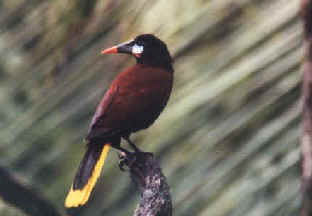
Montezuma Oropendola
From a high observation tower in a forest we visited on the Caribbean slope, Montezuma Oropendolas, though obvious, were not foremost among the birds we saw. Even toucans, as gaudy as they are, became mundane. Tityras (of 2 species) perched at tree-tops were fine, and an eye-level look at a colorful Golden-hooded Tanager was tremendous. As was a look, just below, in flowers, at a beautiful feeding hummingbird called the Purple-crowned Fairy. But the "top honor" went to a startling, bright blue bird, that only sat in a tree across from us. All the bird had to do was appear. It was a male Lovely Cotinga.
There are 3 such striking blue, actually turquoise, cotingas in Central America. One is called the Turquoise Cotinga. In Costa Rica, it's been seen by some atop a bare tree on the property of the famous ornithologist, Alexander Skutch. The other, in Panama, is called the Blue Cotinga. But this bird in Honduras, as turquoise blue as the others, is named the Lovely Cotinga. And not many birds in the world have been given that adjective.
Also lovely were hummingbirds elsewhere in that forest, that during the afternoon, came to bathe at a small pool of a little stream. They were hermits and emeralds. The hermits an overall cinnamon color, the male emerald a vivid bright blue and green with a long tail, the female green and white. The emeralds hovered at the water; the hermits dipped into it. Although the beauty of such nature has been the same for a long time, the names and taxonomy ascribed to the species have changed the Fork-tailed Emerald is now the Salvin's. And what has been the "Little Hermit" is now called the Stripe-throated Hermit. What has been in Central America the "Long-tailed Hermit" is now called the "Long-billed Hermit".
One day, near Lake Yojoa, was a good one for us for owls. A bird that we've called for years the Ferruginous Pygmy-Owl, now called in Central America the Ridgway's Pygmy-Owl, appeared nicely in the open on a upper tree branch. We enjoyed two such sightings that day. During our morning walk, in an open area by the lake, we were fortunate to see two Striped Owls at once, a male and female, "hidden" in a big bush. At a good angle, not so hidden. We saw them well.
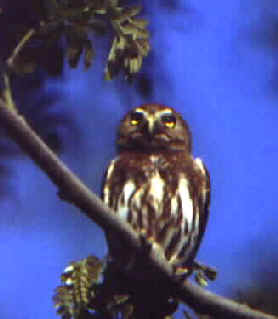
What's been the
Ferruginous Pygmy-Owl
in Central America, the Ridgway's Pygmy-Owl
During an late afternoon boat-ride on the lake, waterbirds were numerous. The Limpkin was particularly enjoyed.
During another boat-ride, another day, on a large coastal lagoon, after seeing some Boat-billed Herons in mangrove trees, we thought there might be spoonbills and who knows what ahead us. Yes, there was Roseate Spoonbill, but it was dwarfed on the shoreline by the lone Jabiru, as it walked about also dwarfing White Ibises, egrets, terns (of 5 species), skimmer, and whatever else it happened to pass.
Not so dwarfed, however, were 5 White Pelicans. Brown Pelicans are common in that area along the Honduran coast of the Caribbean. White Pelicans are very rare. Both species were together. When you travel and bird, you never really know, beforehand, what you're going to see.
One particular sight for us that was wonderful to see, during the tour, was when 4 male White-collared Manakins (with their striking yellow, black, white, and green attire) were together, displaying, hopping up and down, and snapping their wings, in clear view, not just by us, but by both Golden-winged and Blue-winged Warblers that, for some reason, were attracted to also observe the performance.
On another occasion in that forest, that morning, 2 Yellow-bellied Tyrannulets displaying (with wing-lifting) on an open branch, attracted an agitated Magnolia Warbler.
It's nice to see our "summer Warblers" in a different environment, particularly the dapper Hooded Warblers, and the Kentucky Warblers that when south take on the ways of insect-eaters such as antbirds and foliage-gleaners.
Some last highlights of our tour to note included our looking up into trees above us in a forest to see about a dozen Shining Honeycreepers, bright blue, with even brighter yellow legs.
Or, to look into the sky, from along a road in the countryside, to see that one of the Turkey Vultures was actually a very-similar Zone-tailed Hawk.
Or, by the Mayan ruins, to see a Motmot, with it brilliant blue crown, and another, a little later, with its bright turquoise brow.
A third motmot, during our tour, had neither. But it was wonderful to find in the forest, a Tody Motmot, sitting on a branch a short distance from us.
Not seen, oddly, during our tour (even with all we saw) were a House Wren, a Rufous-collared Sparrow (in the highlands) or a Bananaquit! Now, how's that for a good tour?
Upcoming FONT Birding Tours in Honduras
![]()
Chile : With
Birds "Magellanic", "Austral" & "Patagonian"
November 2002
The following account written by Armas Hill, leader of
the tour.
"Magallanes"
is the
southernmost region of the long country of Chile, a country nearly 4,000
kilometers in length. It was one of various regions of the country that we
visited during our Chile Birding Tour in November 2002. "Magallanes"
is named, as is the Strait, for Ferdinand Magellan, who sailed the waters
through the region in about 1520, as his ship circumnavigated the world.
And a number of the world's
most-southerly land and water birds, occurring in that region, are thus named,
including these we encountered during our tour: Magellanic Penguin, Magellanic
Diving-Petrel, Magellanic Flightless Steamer-Duck, Magellanic Oystercatcher,
Magellanic Plover, Magellanic Woodpecker, Magellanic Tapaculo, and more. Some birds known by
more-popular names also have alternate names "Magellanic", such as:
the Upland Goose, also called "Magellan Goose", the Rock
Cormorant, also called the "Magellan Shag", the Dolphin
Gull,
also called "Magellan Gull", and an owl, that used to be considered
Great Horned, now "split" to be the "Magellan Horned
Owl".
All of these birds we saw well in southern Chile, many of them during a
beautiful clear day, with a bright blue sky and distant snow-clad mountains
across that Strait named after Magellan. The day could not have been better. The
owl we saw full-frame in a telescope, as it sat on a ledge. The sun shone on the
dusky gray bodies and the bright red bills and legs of the attractive Dolphin
Gulls that were near us at the water's edge. Joining them on the shoreline
were skuas. Three close Chilean Skuas, lined in a row, with their orange hues in
the sunlight, were also something to see.
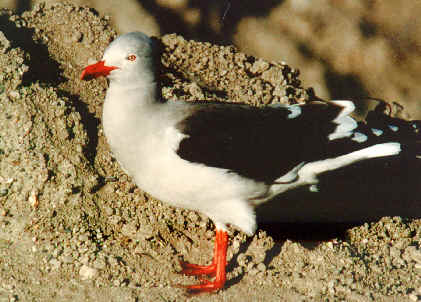
The Dolphin, or Magellan,
Gull
In the water, offshore, Magellanic Penguins swam. The previous day we had seen
them walk, or more aptly put, waddle, at their breeding colony, from their
burrows to a stone beach along the channel into which they dove to feed.
Close to a rocky shore, the Magellan, or Rock, Cormorants also
swam. Further
offshore, from a ferry crossing the Strait, we watched Magellanic Diving-Petrels
fly, with swift wing-beats just above the water's surface. And, yes, they did
dive.
On land, the Magellan, or Upland, Geese were scattered about in pairs on fields,
the males black & white, the females rusty-brown. They, and their attractive
kin, the Ashy-headed Geese, and their rare cousin, the Ruddy-headed
Goose, also
occur on Tierra del Fuego. Magellanic
Oystercatchers, with their young, gave
whistling calls. Steamer-Ducks, that don't fly, were along the shore of
the Strait. Steamer-Ducks, that do fly, were on a lake, where also a flock of
Coscoroba Swans
fed in unison, all-white birds with pink bills. Mostly white were the Chilean
Flamingos with them, young birds not yet as pink overall as they later would be
as adults. The flamingos had just arrived on Tierra del Fuego, having migrated
from the Andes to the north.
But of all the birds we saw named "Magellanic", maybe the best was the
rare Magellanic Plover (that's really, by the way, not a "plover").
Kind of chubby, yet attractive, with a soft-gray and white coloration, with
short pink legs, and pink eyes, the birds can be inconspicuous when standing
against shingle. But during November, their breeding time, when they move,
they're fun to watch, doing a circling "dance" that's kind-of-a
land-version of a phalarope's spin on the water. They can also act rather like a
turnstone, turning over stones as they feed. When they have their young, it's
interesting that Magellanic Plover adults are unique among shorebirds in that
they feed their offspring by regurgitation.
Soft-gray & pink Magellanic Plovers, like the darker gray and red Magellan,
or Dolphin, Gulls, only occur in southernmost South America.
During a drive, along a hilly coastal road on Tierra del Fuego, by the Strait of
Magellan, in addition to many of the occurrences just noted, we were treated to
some bonuses. As a Guanaco stood on a hilltop, and an Andean Condor flew toward
us at nearly eye-level, offshore on the surface of the water, there must have
been thousands of fish, as there were on the water, at a few places, and above
in the sky, thousands of birds. Most apparent were Albatrosses, the Black-browed, also called
"Mollymawks". In one area, there were
certainly over a thousand, both on the water and in flight. Also numerous were
silver-gray Southern Fulmars, Kelp Gulls, South American Terns, and Chilean
Skuas. There were hundreds of skuas in the frenzy with the other
seabirds, that
probably also included many penguins on and under the water's surface.
"Magellanic" was not the only adjective given again & again to
birds during our Chile tour. In the forested land of the Magellanic
Woodpecker and Magellanic Tapaculo,
there were a number of birds named "Austral". That word means
"southerly", and it's the name of a Thrush, a Blackbird, and a
Parakeet (each the southernmost of its kind in the Americas).
A nifty, dapper little bird, in the flycatcher family, that's conspicuous in the
open country, and used to be called the Rufous-backed Negrito, is now called by
some the Austral Negrito, by others, the Patagonian Negrito.
"Patagonia" is a general name of the vast, open, mostly flat,
countyside of southern Chile and Argentina. Other birds called
"Patagonian", in that area, include: the Patagonian Mockingbird,
Patagonian Yellow-Finch, and Patagonian Sierra-Finch. The small Brown-hooded
Gull, superficially similar to a Bonaparte's, is also sometimes called the
Patagonian Black-headed Gull.
The birds, referred to above, were just some of those we enjoyed during the
tour. Torrent Ducks and Moustached Turca were also among the favorites.
Photographs of many of these southern South American birds are in our
accompanying Photo Gallery. You may wish to take a look at some birds there
"Magellanic", "Austral", "Patagonian", and others
too.
The "Top Birds", as voted by participants after our November 2001
Chile Tour, included:
1 - Torrent Duck (Tremendous to watch in the swift current of a river.
Both male & female were seen well. In fact, 2 males seemed to be courting a
female.)
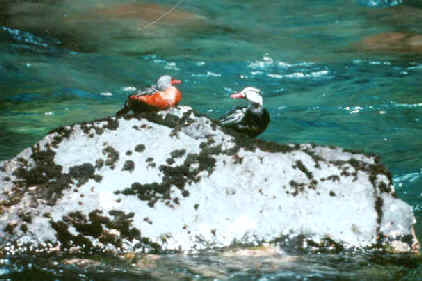
2 - Andean Condor (At one place in the Andes, quite a few flew above us.
One in flight, at eye-level, in Tierra del Fuego, was superb.)
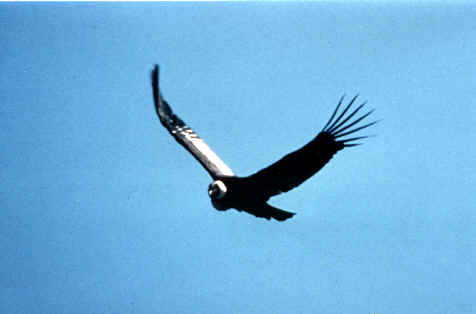
3 - Megallanic Penguin (At the colony in the Far-South, a great experience.)
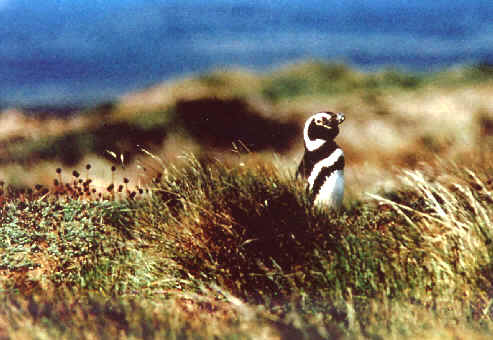
4 - Black-browed Albatross (Close to us on the pelagic trip from
Valparaiso. Also a nice number from the ferry across the Strait of Magellan, and
a huge number feeding elsewhere on the Strait.)
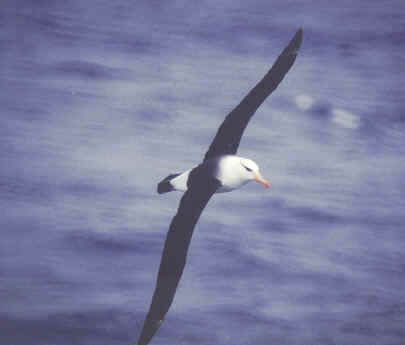
5 - Moustached Turca (Seen running crazily, 3 together, on a slope in the Andes, an odd-looking "Chicken-like" bird with an upright tail. Generally the most-visible of the tapaculos.)
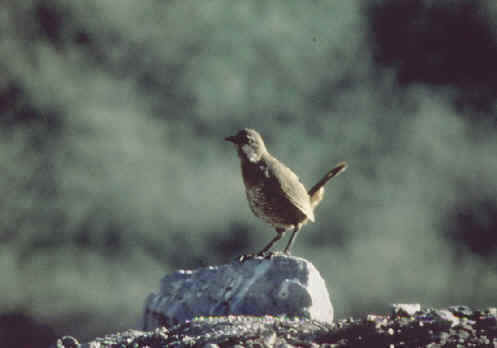
6 - Magellan Horned Owl (We watched it, as its yellow eyes watched us,
from the shadows of a ledge. Our look was "as good as it gets" in a
scope. But how was the bird's look at us thru those yellow eyes, so much
stronger than ours? )
7 - Many-colored Rush-Tyrant (Small, but so colorful. "Siete Colores
de la Laguna", that's, in Spanish, "7 colors, on the little bird by
the lake".)
8 - Cape Petrel (also called the "Pintado", a boldly-patterned
black-and-white seabird that's impossible not to like when it's seen as we saw
it, from our pelagic trip off Valparaiso.)
As many as 44 species of birds received votes in our ballots after the tour,
with each participant voting for their own "Top Ten".
A complete list of birds found during FONT Tours in
Chile.
Our first FONT tour in Chile was in November of 1990. We've been back annually
since, as it is such a beautiful and varied country, easily enjoyed, and with
birding that's "top notch". We look forward to going there again.
Future FONT Birding Tours in Chile & Argentina
![]()
Panama
October-November 2002
The following account written by Armas Hill, leader of
the tour.
This was our third FONT birding
tour in Panama this year. The others were in March and August. In March, we
visited the Chiriqui Highlands and the Lowlands of the Canal Basin. In August,
we were only in the Canal Basin. We spent a fine day in the rainforest on the
Island of Barro Colorado. In the Gatun Lake, created when the Panama Canal was
made. Later, the island was the subject of a book written in 1929, by the
ornithologist, Frank Chapman, entitled "The Tropical Air Castle". To
this day, it's a most interesting place to visit. And, we did so, again, during
our October-November Panama tour, again only in the Canal Basin.
Once again, on Barro Colorado, we enjoyed some fine encounters with antbirds, and other birds, attracted to an ant swarm. No matter how often we see the dapper, little Spotted Antbird, it's a fine sight, particularly when it and other antbirds and woodcreepers were so close to us, only concerned about the ants.
Barro Colorado Island is also a
good place to see mammals. Ocelots and pumas, there, we did not see (not
surprisingly), but we did have fine looks at 3 species of monkeys (including
the nicely-patterned Geoffrey's Tamarin), numerous coatis and agoutis,
and even a White-tailed Deer, running away from us in the forest.
Some aspects of the bird-life during our October-November Panama Tour were
rather different than those earlier in the year. One, particularly so, was a
large, dramatic overhead migration of Turkey Vultures one morning.
Thousands and thousands flew over us, kettle after kettle, and in line after
line. 300 were tallied going past a certain point during a minute, and the same
pace continued for 3 to 4 hours. There were an estimated 80 to 100 thousand
Turkey Vultures journeying south, from central and western North America to
South America. Among them there was a smathering of Swainson's Hawks, and
a few Broad-winged Hawks.
Among the smaller landbirds we found in Panama, in late October and early
November, having migrated from North America, notably evident were Eastern
Wood-Pewees. Their calls, throughout the tour, reminded us of their being
about.
Near the Caribbean Coast, we found Prothonotary Warblers very numerous.
In mangroves and nearby forests, we saw, at least, a few hundred of them. Ten or
so, at one time was not unusual. One one occasion, as many as 7 were in a
binocular-field at once.
Among the neotropical resident
birds we found to be particularly numerous were Collared Aracaris (with
many seen each day) and Purple-throated Fruitcrows in feeding flocks.
Also, toucans (Keel-billed and Chestnut-mandibled) were enjoyed,
as were Yellow-backed Orioles and Red-breasted Blackbirds. We had
some close looks at trogons, motmots, and puffbirds (including
Black-breasted and White-whiskered), and Spot-crowned Barbets.
During our previous tour in August, no Chestnut-headed Oropendolas or Yellow-rumped
Caciques were to be seen. But, in October-November, both species were
conspicuous. One day, late in the afternoon, we saw a flock of at least a couple
hundred Yellow-rumped Caciques going to roost. That species, by the way,
has been "split" now into 2, with the Western Yellow-rumped Cacique
being the bird in Panama.
Probably the "favorite
bird" of our tour was a tame, and beautiful, adult Semiplumbeous Hawk,
sitting on a tree-limb close to us, along a forest road. With its white breast
and bright orange bill, yes, the bird is a beauty. As we watched it, the yellow
eyes of the hawk were watching us.
During our last morning of the tour, it was a mammal, not a bird, that
put on the "final show". A Two-toed Sloth was seen close to us,
in a tree. It was a mother hanging on the tree, with a young hanging on her.
Often sloths don't move much, but this one, as maybe because we were so close,
moved down and then back up the tree. Then, we had to move, ourselves, to the
airport, for home.
In all, a fine tour, with lots of birds, and again some wonderful experiences in Panama.
Upcoming birding tours in Panama.
![]()
The following account written by Armas Hill, leader of the tour.
FONT has conducted a birding
tour in Iceland, during October, annually since 1996. Our October '02 tour was the
second FONT tour of the year on the scenic and interesting island, with the
other tour having been in June.
In June, Icelandic nights are short indeed. In fact, at midnight, during our
June tour, the red ball of the Sun was above the horizon. In October, daylight
lasts from just before 8 o'clock in the morning to about 7 o'clock in the
evening. That gives us ample time to see some fine birds during the day, and
something to look forward to after dark: marvelous displays in the sky of Aurora
Borealis, or "Northern Lights".
For those of us on the night-time flight enroute to Iceland, outside the window
on the left side of the plane, a strong display of the Northern Lights was quite
a sight. Viewing from about 30,000 feet in the air, the waves of floating green
light were something to see, like tall curtains.
Our first two nights in Iceland were unfortunately cloudy, but on the third
night, when we were far away from any ground lights, we stepped out of our
vehicle, and looked up, this time from ground-level, at a sky full of those
waves of floating green light. It was a long and wonderful show above us. The
Northern Lights are known in the Icelandic language as "Norourljos".
It's a great sight to see, yes, but also, at least for those of us not
Icelandic, the word's a mouthful to
say!
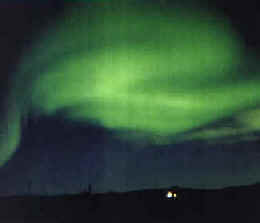
"Norourljos" or
Northern Lights
During the days of our tour, we enjoyed those fine birds we sought, also nice sights to see. Among them were numerous eiders, some colorful Harlequin drakes, Barrow's Goldeneye, groups of Whooper Swans, and a few wonderful close looks at Rock Ptarmigan. Flocks of Purple Sandpipers and European Golden Plovers were close to us. Gulls, of various species, were plentiful. There were many Glaucous Gulls, in assorted plumages. We also saw Iceland Gulls in Iceland. In the summer, that can not be done. The Iceland Gull does not nest in Iceland. It arrives there in October from Greenland.
One afternoon, during a boat-trip in a picturesque area of a large coastal bay, dotted with small rocky islands, we had the good fortune to see 2 adult White-tailed Eagles, certainly symbolic of the remote area where we were. Earlier in the day, a White-tailed Eagle had flown directly in front of us as we traveled along a dirt road, with the bay on one side and cliffs on the other.
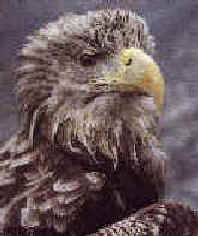
Adult White-tailed Eagle
Also great to see, from the boat on the bay, were a number of Black Guillemots
(not-so-black in October), and a boldly-patterned pair of Long-tailed Ducks.
Unusual during our Iceland tour, this year, were 5 Grey Herons. The species does
not normally breed in Iceland, but in the autumn a few might wander to Iceland
from Norway. Another autumnal wanderer from Norway that we saw was the Eurasian
Curlew. It was along a coastline not far from some Wheatears and Meadow Pipits
that were about to depart for the European
continent.
Landbird species are few in Iceland, but among others that we saw were Redwings
and Redpolls. The former were particularly common, gathered in large flocks
about to begin their migration to the British Isles. Redwings are thrushes.
However, this year, the most interesting of the landbirds were starlings, yes,
starlings: Rose-colored Starlings. We saw 3 of them in a small town in
northwestern Iceland. They were in the company of some Common Starlings. That
species, itself, is a rather new addition to the avifauna of that area, having
spread there only recently from the urbanized area of Reykjavik on the other
side of the island. When I first saw Starlings in the remote northwest last year
I wasn't pleased, but this year I was, as the trio of Rose-colored Starlings had
joined in with them.
The Rose-colored, or Rosy, Starling is a species that breeds normally east of
the Black Sea. But it can be irruptive, on occasion wandering northwest into
Europe. To go, however, to northwestern Iceland, is about as far a bird can
prior to reaching the icecaps of Greenland. Most Rose-colored Starlings, by the
way, travel southeast (rather than northwest) from their breeding range, to
spend the winter in northern India. What an unexpected addition the bird was for
our Iceland list!
Some photographs follow from our October 2002 tour in Iceland (photos by tour participant, Eileen Dunn):
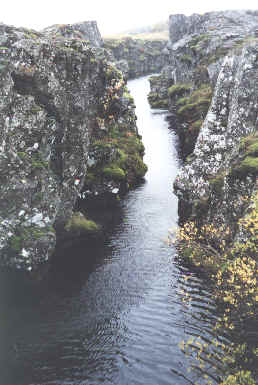
Where Europe meets America, in Iceland where the Mid-Atlantic Rift is above the
ocean.
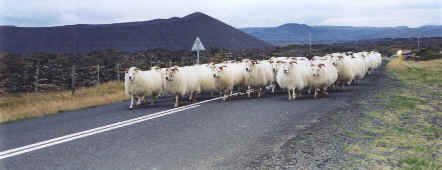
Icelandic sheep walking
along the road.

Some of the participants
of our October 2002
Iceland tour.
Upcoming birding & nature tours in Iceland
![]()
Panama
(a tour with twistwings & softwings)
August 2002
The following account written by Armas Hill, leader of the tour.
Our tour in Panama,
in the summer of '02, was designed as a "get-away", with as much
fine tropical birding as possible, for those without much time. Just shy of a
week, the tour was scheduled when teachers and those who otherwise might not
have been able to, could go. It was the plan to have a tour without much travel
at the destination, but yet with a large number of birds. And that's what
happened. About 200 species were found in just one area in the former Canal
Zone. Some were as bright as the Blue Cotinga and the Green
Shrike-Vireo. Some were as gaudy as the toucans. Others were as
colorful as trogons and tanagers. Conversely, some "just
blended in" with their backgrounds, such as the Broad-billed Sapayoa,
while others, such as the male Red-capped Manakin, were like a beacon one
moment, to be gone the next.
What virtually all of the birds we saw had in common was that they were
"tropical". In mid-August, there were only very few migrants: a Spotted
Sandpiper or two, and a couple Orchard Orioles.
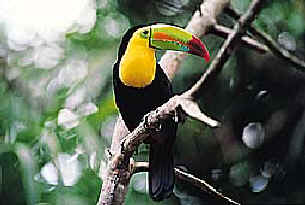
Keel-billed Toucan,
one of the most tropical of birds during
our August 2002 Panamanian Tour.
One of the highlights of the
tour was the visit to Barro Colorado Island,
with its wonderful neotropical forest. Now in the middle of a large lake, the
former hilltop became an island when the Panama Canal was made. The island has
been under the auspices of the Smithsonian Institution for years. Walking there,
in the forest, and around the research facilities, one's mind can drift back
through ornithological history. In the "Tropical Air Castle", names
are remembered of those who studied birds there years ago, Frank Chapman and
Alexander Wetmore.
But one's mind can't drift very long when in that forest. There's too much to
experience. There's too much to see, and to hear. One must be continually
looking and listening. And then wonderful things are seen.
That's what happened for us when we came upon a swarm of ants that was on the
ground, in the leaf litter, and on nearby roots and limbs. It was a swarm with a
tremendous accompaniment of birds. We stood ever so still (but smartly not atop
the ants!) The dapper Spotted Antbirds on twigs just a few feet from us
were so involved with the ants as to be oblivious to us. As were the Bicolored
Antbirds and Western Slaty-Antshrikes. Not only antbirds, but
also woodcreepers and flycatchers were attracted to the
insectivorous gathering.
Some White-whiskered
Puffbirds were also drawn to the fray. They perch ever so still, that is
when they're not feeding on insects. Another name for the brown, streaked bird
is the White-whiskered Softwing. It's a nice name. One can remember a
nice essay by Alexander Skutch about the bird.
Another bird that's brown, in the forest with us at Barro Colorado was a bird that's been called the Brownish Flycatcher.
It doesn't sound like much, but a "new" name for the bird that's more
intriguing is the Brownish Twistwing. During a walk along one trail at
Barro Colorado we were treated to both twistwings and softwings.
Along another portion of trail, we stood still again, to watch a Great
Tinamou, itself still, on the ground, before it walked slowly away.
Elsewhere, on a limb above us a Crested Guan eyed us as we eyed it.
But certainly among our best Panamanian forest experiences, during the tour,
were those with the Song
Wren. We had some nice encounters with the bird, seeing it well a few times. The species is
normally a skulker, more readily heard than seen. At one particular
place and time, we were lucky to see 4 Song Wrens in front of us at once,
walking slowly about on the ground, and then up onto on arching twigs. And then
one of Song Wrens even sang. It was one of the thrills of the tour. The sound is
beautiful. The bird, when seen, resembles one or two of the antbirds, with
rufous and brown coloration, and a blue ring around the eye. Its bill appears
longer than its tail. It may not be. But the tail is short.
Seeing the birds referred to here (and others) in that "Tropical Air
Castle", the neotropical forest, enabled us to take home, even after a
relatively short visit, some wonderful memories.
Not only birds did we see during our week or so in Panama. We also saw a number
of animals: capuchins and howler monkeys, tamarins, tamanduas, a tayra,
sloths, capybaras, coatimundis, agoutis, raccoon, armadillo, opossum,
squirrels, and bats. Along with huge numbers of leaf-cutting ants,
beautiful butterflies, frogs, and even a snake or two.
Not bad for just shy of a week. See our list of
birds we've found in Panama.
Upcoming tours in Panama
The following came by
e-mail to FONT from an August 2002 Panama tour participant after the tour:
From Ann Shadwick, of Pacifica, California, USA:
Thanks so much for a wonderful
tour!
![]()
Minas
Gerais, Brazil
August 2002
The following account written by Armas Hill, leader of the tour.
This was the third in our set of 3 Brazilian birding tours during the summer of '02. Each of the 3 was a week. During the combined 3-week set a total of 500 species of birds were found. Cumulatively, 879 species of birds have been found during FONT tours in Brazil.
During our week in the state of Brazil known as Minas Gerais, among the birds were some fine rarities and specialties.
Among them,
was the very rare Brazilian Merganser. At a place called Canastra, a pair
was seen well. The birds flew in, close by us, to a small river. Once on the
water, they swan for a while, as they began to feed on small fish. With the sun
behind us, and the birds in close, we were treated to wonderful looks, both by
telescope and in binoculars. When the pair flew in, our eyes beheld a thrilling
sight. They came rather unexpectedly. The whole experience was truly superb, as
the Brazilian Merganser is not only the rarest of ducks in the Americas, it is
one of the rarest of world’s birds. Recent estimates have put the population
at only about a hundred pairs. And some say that’s even too high a number.
With large territories, and favoring remote areas, it is not an easy bird to
see.
The
species, however, has also been seen during 2 previous FONT tours: in March
1997, and in October 1998. During both times previously, it was also seen in the
Canastra area of western Minas Gerais. Now, with our latest sighting, the bird
has been found during a FONT Brazilian birding tour during the month of August.
The Brazilian Merganser’s range has included southeast
Brazil, northeast Argentina, and adjacent Paraguay. It’s probably now extinct
in Paraguay, and may be in Argentina (where the population has been critically
small). Actually, in the mid-20th Century, the species was thought to
be extinct altogether. It was re-found in 1948. Now, just over 50 years later,
the bird is still "too close" to extinction.
Another
rarity, and a local speciality, seen during our August 2002 tour in the
Brazilian state of Minas Gerais, was the Cipo Canastero. It’s a bird
that became known to science only as recently as 1985. When the species was
discovered, it was a surprise as all other canasteros occur much further
to the west in South America, and mostly in Andean habitats.
We’ve
had Cipo Canastero sightings have been during all of our tours to where the
species was initially found. Those tours, over the years, have been in March,
August, and October.
A third
rarity, during our August 2002 Brazil tour in Minas Gerais was the Three-toed
Jacamar (having 3 toes instead of 4). This Brazilian endemic has, during
recent years, undergone a major decline in numbers, and a contraction of its
range.
Other highlights of the Minas Gerais portion of our Brazil
'02 summer tours included a beautiful Aplomado Falcon perched in the
late-afternoon sunlight, a fine assortment of antbirds in the forest, by
day, at Caraca, where a Maned Wolf was seen after dark, and a wonderful
close-up encounter with Swallow-tailed Cotingas and numerous other birds,
notably hummingbirds, near the attractive historic city of Ouro Preto.
Our upcoming Brazil birding tours.
![]()
The following account written by Armas Hill, leader of the tour.
A few miles to the north, in the
region of Mato Grosso known as the "Chapada", the cast of avian
characters is quite different. On the higher plateau, there, species occur that
favor the dry habitat known as the "cerrado". And forests have a mixed
recipe of some Amazonian and non-Amazonian species.
In the "cerrado", we had a tremendous look at a Collared
Crescent-chest (an attractive tapaculo). And we also had some good encounters
with the Checkered Woodpecker, Rusty-backed Antwren, Blue-tufted Starthroat,
Curl-crested Jay and Coal-crested Finch, and both the White-rumped
and
White-banded Tanagers (the latter incidentally looks alot like a North American
Loggerhead Shrike). Large birds were still to be seen: there were pairs of
Red-and-green Macaws flying about, calling raucously as they went. We enjoyed,
at the end of an afternoon, by a cliff above a beautiful waterfall, a
particularly-pleasing encounter, eye-to-eye with a pair of Blue-winged
Macaws.
In the forest, our birds included Tataupa Tinamou, Pheasant Cuckoo, White-wedged
Piculet, Green-backed Becard, Eastern Sirystes, White-backed Fire-eye, and
Lettered Aracari.
Further north, the birds became
more "Amazonian" in an area that we've liked to visit during our
previous FONT
birding tours in Mato Grosso: the Jardim da
Amazonia (or the "Garden of the Amazon"). During the past 3 years
(since it opened), 6 FONT tours have visited the place. A
fine list of birds has cumulatively been seen. During this tour, among the
birds there that we particularly enjoyed seeing were Black-girdled Barbets,
and Paradise Tanagers, the latter in a flock with other tanagers and
allies indigenous to the Amazon basin. Related to tanagers, and also colorful
were both Yellow-bellied and Black-faced Dacnis.
During an afternoon boat-ride along the pristine Rio Claro, at the day's end, on
a tree limb above the river's edge, there was a Great Potoo. A great
sight! And those dark eyes of the potoo looked at us too. It was one of many
fine moments during our 2002 tour in Mato Grosso, Brazil.
Our upcoming Brazil birding tours.
![]()
The following account written by Armas Hill, leader of the tour.
![]()
Iceland
June 2002
The following account written by Armas Hill, leader of
the tour.
On June 10, 2002, as midnight
approached, we were at the front of our hotel in the small Icelandic town of Stykkisholmur,
on the shore of the large bay called Breidafjordur.
During our annual Icelandic tours in October, from the very same place, after dark, we've seen some
tremendous displays in the sky of "Northern
Lights" or Aurora Borealis.
As we were there during our June 2002 tour, in the sky at midnight the
orange ball of the Sun lingered low in the sky. It was near the horizon,
appearing as if it were soon to set. But instead our "Midnight Sun"
continued to slide ever so gradually to the north. About 40 minutes later, it
finally slipped below the horizon, above which it would rise the following
hour. The fishing town Stykkisholmur is not far (only about 50 miles) south of
the Arctic Circle. It was quite an experience to see a full, bright disk of a
"Midnight Sun" in the sky from this same place where previously we've
seen overhead the colorful floating forms of the Northern Lights. Both of
the phenomena were so beautiful, in a land where the air is about as clear
as it can be anywhere.
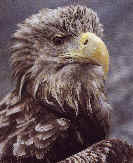
An Icelandic adult
White-tailed Eagle
The following morning, from a boat, on
the large bay called Breidafjordur, we enjoyed some other wonderful sights,
including an
adult White-tailed Eagle, sitting on its nest, atop a rock ledge, with
the frosty feathers of its head blowing in the wind, while nearby there were Puffins,
dozens of them, standing on the cliff-tops, flying about, and swimming in the
water. The captain of the boat told us that examination of the eagle's nest, the
previous year after the young had fledged, showed there to be many bones and
other remnants of puffins.
The White-tailed Eagle has a large range, from
Greenland east to Hokkaido, Japan, and north of there in Siberia. But nowhere
else in that range would a prime food of the eagles in the summer be the Atlantic
Puffin. There are not many White-tailed Eagles in Iceland, only about
50 pairs. On the other hand, in Iceland, there are many Atlantic Puffins, with more nesting
there than anywhere else in the world, about 3 million pairs.

Puffins in Iceland
Other enjoyable sights from the boat on Breidafjordur included numerous Common
Eiders (with the males in brilliant plumage), Black Guillemots with
their bright red feet, swimming in the water next to us, and Shags with their green
eyes, sitting still cliffside on their nests (yes, the boat did get close enough
to the cliff for us to see in our binoculars the green of the eyes).
A couple days earlier, we were in eastern Iceland, near the coast, by a very
large glacial area called Vatnajokull. This
vast ice-cap is said to be the third largest in the world, after those of Antarctica and
Greenland. Near where the glacier is close to the sea, on big chunks of ice,
some quite blue, there were large flocks of resting birds: mostly Kittiwakes,
also Arctic Terns.
In the water, near the boldly-patterned Eiders,
there were ever-so-colorful Harlequin drakes. Nearby, on a small pond,
there was a pair of breeding-plumaged Red-throated Loons in breeding
plumage.
But the highlights of eastern Iceland had to have been the Skuas and Jaegers.
We saw Great Skuas, walking on the gravel where they would nest. One was
seen displaying to another. Wow! In that region of Iceland, nearly half of the Great
Skua global population breeds, between 5 and 6 thousand pairs.
The Parasitic Jaegers in that area, and elsewhere in Iceland, were tremendous to
see, in flight and on the ground. Interesting was the large number of these
jaegers that were dark morphs. According to the literature, about a third of the
jaegers that nest in Iceland are
dark.
Very impressive, during our tour, were huge numbers of Northern Fulmars.
There were millions. Nearly every cliffside had swarms of them flying about,
with as many sitting on the ledges. Historically, Fulmars were not common in
Iceland. They certainly are now. At one place, where there was a spectacular,
large waterfall on the side of a tall cliff, as I looked at a group a tourists, I
thought of how they must have thought that the many birds flying about, with stiff
wingbeats, were "gulls".
Another species, also numerous, was the Arctic Tern. At one point, as we
drove along a dirt road, we passed right through a large colony. We stopped our
vehicle and were surrounding by the mass of flying, sitting, and calling birds. These
birds are said to migrate, when away from Iceland, more than any other species,
going thousands of miles to southern Africa, and even beyond into the Indian
Ocean. As we were there, they were sitting on that dirt, ahead of us, and behind
us, by the hundreds.
When we continued further along the road, we found
ourselves at a rocky coast with thousands of other seabirds: Gannets,
Kittiwakes, Common and Thick-billed Murres, and Razorbills. By
our parked vehicle, there was another black-and-white bird, a male Snow
Bunting, in breeding plumage, singing its
song.
In the interior of Iceland, high on tundra, we saw a flock of Pink-footed
Geese (Iceland is a prime breeding locality for the species). At another
place, there was a Rock Ptarmigan doing its display flight.
Actually, during the tour, we saw a number of breeding birds, of various species, displaying.
And among them a number of shorebirds: European Golden Plover, Ringed Plover,
Eurasian Oystercatcher, Whimbrel, Common Redshank, and Common Snipe.
And, about as attractive as a breeding shorebird can be, there were pairs of Red-necked
Phalaropes spinning on pools.
On lowland fields, sometimes near the famous Icelandic Horses, were pairs of Whooper
Swans. They did not yet have their cygnets. However, we did see female eiders
sometimes with groups of a dozen or more ducklings (according to the books,
some adults of the species raise their young and those of others). Ravens
were seen at their nests. On lawns and fields, thrushes known as Redwings
were paired, with their young of the year to come. Other passerines included Northern
Wheatear and White Wagtail, Meadow Pipit, and a resident race of the Wren.
Having such fine birding, in such a fascinating and picturesque country, was
certainly a wonderful experience for all 9 of us on the tour.

FONT tour group in
Iceland, June 2002.
(This and following photos courtesy of Wayne & Carol Pembroke.)
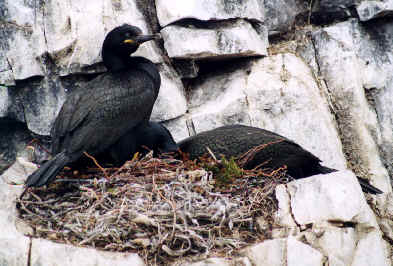
Shags nesting near
Stykkisholmur, Iceland.
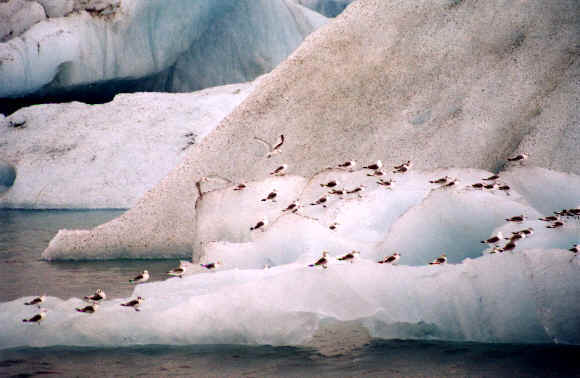
Flocks of Kittiwakes on
Iceland glacial ice, June 2002.
The following came by letter and e-mail to FONT from June 2002 Iceland tour
participants after the tour:
From Rebecca & Jack Matlock, of Princeton, New Jersey, USA:
Dear Armas,
We enjoyed every minute of our recent
tour with you in Iceland... Again, thanks, thanks.
From Carol & Wayne Pembroke, of Webster, New York, USA:
Hello Armas,
We had a fabulous time (during the Iceland Tour) that FAR exceeded our pre-trip
thoughts!
Ended up with 61 species and 5 lifers.
We truly appreciated your effort and hard work during the tour.
Pictures turned out great and will send you some.
Good fortune in all your future endeavors.
![]()
North
Carolina, USA Landbirding
June 2002
The following account written by Armas Hill, leader of the tour.
During our annual "Carolina Caper" Landbirding Tour, in June 2002, in North Carolina, among the birds were all of the "southern warblers" sought. Prothonotary Warblers were particularly numerous. There were also: Hooded, Kentucky, Worm-eating, Yellow-throated, Parula, Pine, Louisiana Waterthrush, and Yellow-breasted Chat. The Black-throated Green was the southerly race known as the "Wayne's Warbler". That bird named after Arthur Wayne who found as many as 32 nests of the Bachman's Warbler between 1906 and 1918. Unfortunately that "southern warbler", the Bachman's, is unfortunately no longer to be seen. Incidentally, no Bachman's Warbler nest was ever seen again in South Carolina after 1918.
But a "southern warbler" that was seen (and seen well) during our 2002 "Carolina Caper" was the Swainson's Warbler - a skulker in dense undercover, clad a dull brown, but yet a nice bird to see. And to hear, with its fine song. Arthur Wayne, just referred to, found the first nest of the Swainson's Warbler back in 1885. It's interesting that the Swainson's Warbler had "disappeared" from science for 50 years prior to that, following its discovery about 1833 by John Bachman (after whom the Bachman's Warbler was named). The Swainson's Warbler was named after the English naturalist William Swainson, by his friend John James Audubon.
Whereas the Bachman's Warbler is no longer to be seen, the Bachman's Sparrow of the Carolina Pinewoods can be. It was among the bird specialties that we saw of that habitat. Others, by day, were the rare and endangered Red-cockaded Woodpecker and the common Brown-headed Nuthatch. At dusk, in the pines, there were displaying Common Nighthawks and both Chuck-Will's-Widows and Whip-Poor-Wills.
Other niceties that were enjoyed during our tour were the colorful Painted Bunting, the dapper Red-headed Woodpecker, and displaying Yellow-breasted Chat. Inland, Mississippi Kite was seen, in an area where a group of them have been doing acrobatics in the air catching dragonflies.
Owls during the tour included both red and gray Screech, a flying Great Horned, and calling Barred. What was not seen, or heard, unfortunately, this year, was the Black Rail. At a place where they normally occur, only the Clapper and Virginia Rails were vocal.
There's a complete list of birds found during FONT tours in North Carolina, USA, elsewhere in our web-site.
![]()
Alaska
(including the Pribilofs)
May-June 2002
The following photographs were taken during the tour by Peter Ferrera, mostly on the Pribilofs :
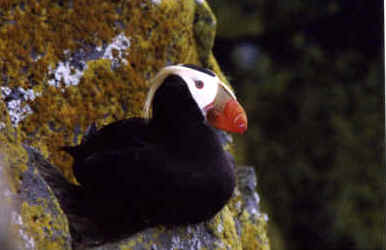
Tufted Puffin in the
Pribilofs.
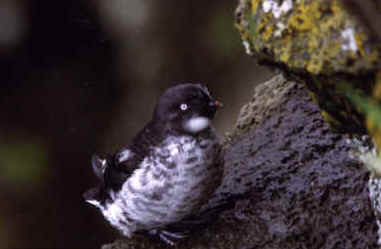
Least Auklet in the Pribilofs.
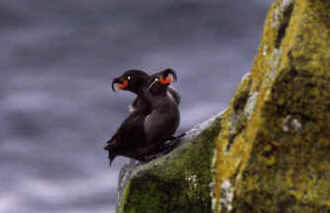
Crested Auklets in the Pribilofs.
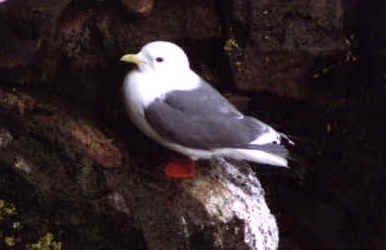
Red-legged Kittiwake in the Pribilofs.
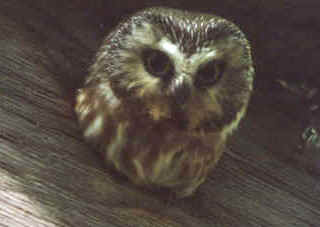
Saw-whet Owl near Anchorage.
![]()
Spring
Birding in Southern Japan
May 2002
The following account written by Armas Hill, leader of the tour.
Over the years, FONT has conducted a number of birding tours on the Southern Japanese Island of
Okinawa, where among the interesting birds there are 2 endemics to the island the Pryer's Woodpecker and the Okinawa Rail.The woodpecker is very rare. Assuming the Ivory-billed Woodpecker to be extinct, the Pryer's would be the rarest of the world's woodpeckers, only occurring in a limited area of forest in northern Okinawa. Population estimates have ranged from 40 to 200 birds. During our current tour on the island, as we walked along a trail in a woods by a stream, we found ourselves face-to-face with a Pryer's Woodpecker, bringing food to young in a nest. This was the first of 8 Pryer's Woodpeckers to be seen during the tour. And we heard the young woodpeckers inside the nest cavity.
The Okinawa Rail was only "discovered" in 1981, new to science at that time, although known for years by locals to be in the Yambaru Region of Okinawa. The bird can be very hard to see. Secretive, shy, in the forest or high grass. Thus, it was "unknown" as long as it was. During our tour now in Okinawa, during the early morning of
May 16, 2002, we saw a total of 11 Okinawa Rails (and heard another). The birds were seen along a stretch of road, as we moved slowly in our vehicle. At one time, as we remained still on the road, there were 3 rails ahead of us. One, more closely, was feeding on low vegetation along the side of the road. Two were behind it. One of them raised its neck and began to call. On another occasion, as we sat still, an Okinawa Rail was walking along the road edge, just about 15-feet from us. The species is quite attractive, with a bright red bill and legs, a black-and-white barred belly, a mostly black head with a white stripe and red eyes.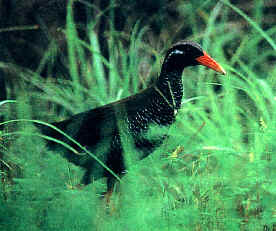
Okinawa Rail
Also attractive during our May 2002 tour in Okinawa have been at least 4 Greater Painted-Snipes seen well in a rice paddy (females more colorful as in phalaropes), a Ruddy Crake with 2 black chicks, Ryukyu Robins (at least 20 seen well), and Japanese Paradise Flycatchers. At an estuary, we observed 2 Terek Sandpipers with a flock of Grey-tailed Tattlers.
The "Top Birds" as voted by
participants after the tour were:
1 - Okinawa Rail
2 - Pryer's Woodpecker
3 - Oriental Pratincole
4 - Ruddy Kingfisher
5 - Greater Painted-Snipe
6 - "Owston's" White-backed Woodpecker
7 - Terek Sandpiper
8 - Japanese Paradise-Flycatcher
9 - Narcissus Flycatcher
10 - Ryukyu (formerly part of Narcissus) Flycatcher
11- Grey-faced Buzzard
12 - Japanese Reed Bunting
13 - Ryukyu Robin
14 - Mongolian Plover
15 - Ryukyu Scops-Owl
16 - Japanese Green Pheasant
17 - Sharp-tailed Sandpiper
18 - Little Stint (rare in Japan, seen well)
19 - Azure-winged Magpie
20 - Great Knot
21 - Needle-tailed Swift
22 - Oriental Scops-Owl
23 - Japanese Wagtail
A booklet listing the 353 species of birds that have been found during FONT tours in Japan, noting when and where, is available from FONT. Let us know if you'd like a copy.
Upcoming
Japan Tours.
To
Top of Page
![]()
Spring
Birding in Central Japan
May 2002
The following account written by Armas Hill, leader of the tour.
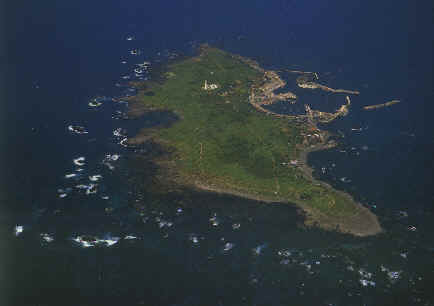
Hegura-jima
(pictured above) is a small, very small, island in the Sea of Japan, where there can be a large migration of birds. The island is just over a mile long, and just about half a mile wide. It is located about 35 miles offshore from western Honshu, the main Japanese island.During the
FONT 2002 Early-Spring Birding Tour in Japan, we went again to Hegura Island (this time in early May). We visited the island previously during our tour in 2001 (in late April).Again in 2002, as in 2001, we had some extraordinary birding. This year, among the best of the birds were the Swinhoe's Robin, Mugimaki Flycatcher, Tristram's Bunting, and Dusky Warbler. The most obvious bird on the island, during our stay in 2002, was the attractive Narcissus Flycatcher. Colorful, and tame, they always seemed to be with us.
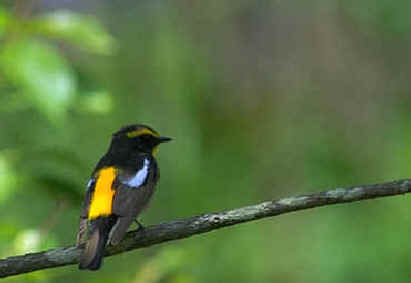
Narcissus Flycatcher
Also there were Siberian Blue Robin, White's Ground-Thrush, Eye-browed Thrush, Violet-backed Starling, and Yellow-throated Bunting. During the time of our visit, there were always birds about, and Japanese birders with whom we shared our wonderful experience on the island and an exciting phenomenon of bird migration.
Returning from Hegura Island to Honshu, we had with us, during our entire 2-hour ferry ride, Streaked Shearwaters, thousands of them.
Before going to Hegura-jima, on Honshu we observed a noteworthy assortment of migrating shorebirds (or waders), including both Great and Red Knots, thousands of Pacific Golden-Plovers, colorful Mongolian Plovers in breeding plumage, Red-necked Stints in bright breeding plumage as well, and a Broad-billed Sandpiper among Dunlin and Grey-tailed Tattlers, to mention a few of the shorebird species.
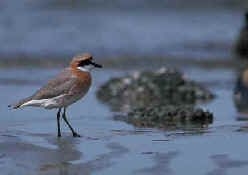
Mongolian Plover
Among landbirds on Honshu during the tour were both the Japanese Reed Bunting and Japanese Yellow Bunting (both rare species), breeding Mandarin Ducks, and also colorful Japanese Green Pheasants, and Japanese Grosbeaks. Also among the five assortment of birds found, there was a single (late) male Smew, and a line-up on a branch of 10 young Long-tailed Tits, huddled together, as they were being fed by adults.
The "Top Birds" as voted by
participants after the tour were:
1 - Narcissus Flycatcher
2 - Mugimaki Flycatcher
3 - Tristram's Bunting
4 - Siberian Blue Robin
5 - Long-tailed Tit (line-up of 10 young on a branch)
6 - Japanese Marsh Warbler
7 - White's Ground-Thrush
8 - Swinhoe's Robin
9 - Brown Dipper
10 - Mongolian Plover
11- Varied Tit
12 - Japanese Green Pheasant
13 - Japanese Green Woodpecker
14 - Broad-billed Sandpiper
15 - Yellow-throated Bunting
16 - Great Knot
17 - Japanese Bush Warbler (singing)
18 - Mandarin Duck
19 - Streaked Shearwater
20 - Japanese Grosbeak
A booklet listing the 353 species of birds that have been found during FONT tours in Japan, noting when and where, is available from FONT. Let us know if you'd like a copy.
Upcoming
Japan Tours.
To
Top of Page
![]()
Colorado/Kansas
Tour for Grouse & more
April 2002
The following account written by Art McMorris, who co-led the tour with John Janowski.
In this, the 3rd year for FONT's
"All-Grouse Get-Out," we once again looked for, and found, all of the
grouse of Colorado and southwestern Kansas: Greater Prairie Chicken, Lesser
Prairie Chicken, Sharp-tailed Grouse, Greater Sage Grouse, Gunnison Sage Grouse,
Blue Grouse, and White-tailed Ptarmigan.
Lesser Prairie Chickens and Gunnison Sage Grouse are among the rarest birds in
North America, and White-tailed Ptarmigan are among the toughest birds to
find.
This is the time of year that the Prairie Chickens, Sharp-tailed Grouse and
Sage
Grouse congregate on their leks for their communal mating displays, and we were
greatly entertained by their booming, strutting and dancing. In all, we found
and enjoyed a great many specialty birds of the western mountains and plains,
and enjoyed spectacular and varied scenery during our tour which took
us to all four corners of Colorado plus a brief foray into Kansas.
Early-arriving participants enjoyed an afternoon of pre-tour birding in the mountains to the west of Colorado Springs, where we enjoyed our first taste of birds of western North America: Townsend’s Solitaire, Evening Grosbeak, Western and Mountain Bluebirds, Swainson’s Hawk, Common Raven, (Gray-headed) Dark-eyed Junco, Clark’s Nutcracker, Wild Turkey and, returning early because of the early spring, Williamson’s Sapsucker: two males and three females, in their strikingly different plumage. Before the trip was over we would find this stunning species at 3 different localities.
The tour proper began on
Saturday, April 20 with a drive from Colorado Springs to Elkhart, Kansas, the
heart of Lesser Prairie Chicken country. Stops along the way in the short-grass
prairie and at prairie ponds yielded
4 species of grebe (Clark’s, Western, Eared and Pied-billed),
American Avocet,
Long-billed Curlew, and American Pipit.
Three special treats that day were Franklin’s Gulls in breeding plumage with
their rosy breasts, a pair of Great Horned Owls at a nest, and pairs of
Chihuahuan Ravens doing awe-inspiring flight displays, matching each other’s
every maneuver while flying nearly wingtip to wingtip.
Sunrise on Sunday morning found
us at the Lesser Prairie Chicken lek where we watched 21 males do their mating
dance for 2 females. Burrowing Owls and Lark Buntings looked on at the
spectacle, while singing Horned Larks and Western Meadowlarks provided musical
accompaniment. We then headed north through the prairie where we watched
Swainson’s and Ferruginous Hawks hunt. A stop at a prairie reservoir produced
Franklin’s, Ring-billed, Bonaparte’s and California Gulls and a good
assortment of waterfowl including all three teal, Redhead and
Common Loon in
breeding plumage, and three "Blue" Snow Geese and a Ross' Goose
among a flock of Snow Geese. Our stop for the night was in the tall-grass
prairie of northeastern Colorado, home of the Greater Prairie Chicken. A stop at
the lek in the evening gave us our first views of this bird, making it a
2-prairie-chicken day.
The next morning we again visited the Greater Prairie Chicken lek to witness
their mating dance, which gave the Native Americans inspiration for many of
their dances. We then visited the Pawnee Grasslands area, where we found many
more prairie species including McCown’s Longspur, Lark and Vesper Sparrows,
Say’s Phoebe, and Prairie Falcon, the fastest-flying bird in the world.
We then began our westward trip into the mountains, where our first stop produced Red-breasted, White-breasted and Pygmy Nuthatch, Gray Jay, Red-naped and Williamson’s Sapsucker, Mountain Bluebird, Mountain Chickadee, and two Northern Goshawks doing flight displays. As we lunched, we watched Bighorn Sheep clamber about the rocks high above us. We then continued our ascent to Guanella Pass at 11,500 feet on the Continental Divide, where White-tailed Ptarmigan spend the winter in their exquisite snow-white plumage. In spite of the very early spring and an early snowmelt, we managed to find one of these elusive birds. Also at the pass (and giving evidence of the early spring) we found arriving Horned Larks, American Pipits, Mountain Chickadees, and a Snowshoe Hare. On our descent we watched dippers foraging in the mountain streams and, in another visit to this beautiful area the following morning, we found the "Slate-colored" Rocky Mountain form of the Fox Sparrow, said by some to be a separate species.
Next we headed north to North Park, the high intermountain plateau or north-central Colorado, characterized by sage brush and its associated bird life. In the mountains along the way we found Brown-capped and Gray-crowned Rosy Finches, "Gray-headed" Dark-eyed Juncos, and a brilliant male Pine Grosbeak. Another stop at a reservoir gave us superb looks at Common and Barrow’s Goldeneye, Common Merganser, and many other species in transit to their breeding areas. Then, as we were in transit, we saw a cow giving birth to a calf! Later, an evening stop at the Sage Grouse lek-site we had our first looks at Golden Eagle and all 3 of the birds with the adjective "sage": Greater Sage Grouse, Sage Sparrow and Sage Thrasher.
A return to the lek the following morning gave us excellent looks at 33 male Greater Sage Grouse doing their mating dance and giving their bubble-popping "boom" for the benefit of one female, and more looks at Sage Sparrow and Sage Thrasher. Before leaving this beautiful area we made stops at a pond where we saw Mountain Bluebirds, various ducks, grebes and gulls, and Common Snipe doing their territorial calls and winnowing displays. A visit to a forested area produced recently-returning Red-naped Sapsuckers, drumming and setting up their territories in the aspens, and Ruby-crowned Kinglets displaying with their brilliant crests erected. Then we continued west, making a stop at the third site where we found Williamson’s Sapsucker. Further west, in the one small area of Colorado where Sandhill Cranes breed, we saw a number of the stately birds.
Our first target for Friday
morning was Blue Grouse, and we were not disappointed: a beautiful male
displaying right by the side of the road gave all of us excellent looks. Another
bird spotted this morning was the Spotted Towhee, singing and calling in the
brush. We then set out for the Sharp-tailed Grouse lek, where we watched a dozen
or more males give their wind-up-toy display: wings arched, head down, tail
erect, rapidly stomping their feet. Elk and Pronghorn on the hillsides provided
a fitting backdrop.
We then traveled south towards Gunnison, choosing a route over Grand Mesa
through topography which is quite different from that of the mountains further
east. At the beginning of our ascent, the canyon was hot and dry, and we found
Canyon Wren; White-throated Swift; Tree, Cliff and Violet-green
Swallows; and a
dipper foraging in the stream and feeding its loudly-calling chicks at the nest.
Just an hour later we stopped and enjoyed the stunning scenery at the top of the
mesa where it was still winter, and snowing! Upon our descent on the other side
we visited an arid canyon where we found Rock Wren, Brewer’s Sparrow, Lark
Sparrow, White-crowned Sparrow, Green-tailed Towhee, and "Audubon’s"
Yellow-rumped Warblers, impressive in their fresh breeding plumage.
Saturday, our last birding day and our last pre-dawn rise, we visited the lek for Gunnison Sage-Grouse, one of the rarest birds in North America and just recently recognized as a separate species distinct from Greater Sage Grouse. In spite of a gathering storm, 12 males came and displayed for a half hour before the snow started. We then headed back east, making a stop at Buena Vista ("Beautiful View"), where we had stunning views of pinyon-covered foothills and snow-capped mountain peaks. Our target bird here was Pinyon Jay. While looking for these elusive corvids we had our best looks of White-faced Ibis, plus Chipping and Brewer’s Sparrows, bushes full of Bushtits; Mountain Bluebirds; and both Western Scrub Jays and Steller’s Jays: everything blue-and-jay except our target. And then a Pinyon Jay was spotted in the distance, and the chase was on! We tracked down the wandering flock, and enjoyed great views of these nomadic birds. Continuing east we made our final birding stop along the Arkansas River where we found 6 species of swallows (Tree, Violet-green, Northern Rough-winged, Bank, Cliff and Barn), as well as some unexpected birds such as Green Heron.
Our total for the trip was 159
species (included in the cumulative bird-list for the tour).
The "top birds" of the tour, as voted afterwards by the participants, were:
1. Sharp-tailed Grouse
2. Williamson's Sapsucker
3. Lesser Prairie Chicken
4. Greater Sage Grouse
5. American Dipper (at nest)
6. Northern Goshawk
7. Blue Grouse
8. Ferruginous Hawk
9. McCown's Longspur
10. Pine Grosbeak
11. Green-tailed Towhee
12. Red-naped Sapsucker
13. Pinyon Jay
14. Greater Prairie Chicken
15. Prairie Falcon
16. "Audubon's" Yellow-rumped Warblers (in gorgeous breeding plumage)
17. Gray-crowned Rosy Finch
18. Common Merganser (pair)
19. White-tailed Ptarmigan
20. Brown-capped Rosy Finch
And honorable mention goes to:
Broad-winged Hawk, Mountain Bluebird, Barrow's Goldeneye, Black-billed Magpie, Franklin's Gulls with pink breasts, Ruby-crowned Kinglets displaying, Horned Larks displaying, Yellow-headed Blackbird, Golden Eagle, California Gull, Lark Sparrow, Sandhill Crane, Swainson's Hawk.
Upcoming
Colorado Tour
To
Top of Page
![]()
The following account written by Armas Hill, leader of the tour.
During our Guatemala birding tour earlier
in 2002, in January, we had the good fortune to see a pair of Orange-breasted
Falcons at Temple 4 in the Mayan ruins at Tikal. Years ago in the 1980's, at
Tikal there was a pair of Orange-breasted Falcons. Then for years there were
none. Traditionally at Tikal, Orange-breasted Falcons established their eyries
in January (at the end of the rainy season) and laid 2 or 3 eggs in March
(during the dry season). And so, as hoped, the pair of Orange-breasted Falcons
was still at Temple 4 when we returned to Tikal in April.
Both birds of the pair were seen: the female above us on a ledge, and later
flying into a cavity near the top of the temple, and a male perched not far away
on a treetop.
Earlier that same day, as we were entering the set of Tikal ruins known as
Complex 2, a large bird was seen overhead, doing a steady, straight flight
directly above us. The large bird was another rarely-seen raptor, a Crested
Eagle. Rather similar to the Harpy Eagle, both species (the Crested and the
Harpy) are only infrequently seen in their large ranges. Formerly the Crested
Eagle was said to occur from Honduras to Brazil, but there have been relatively
recent breeding records for the species in northern Guatemala and nearby Belize.
The bird that we saw at Tikal was a pale adult (much like 213ax on plate 72 in
the new "Raptors of the World" by Ferguson-Lees and Christie, but
slightly darker). There are intermediates between the pale and dark morphs.
Much smaller birds that we saw at Tikal included colorful White-collared
Manakin performing at its lek, and a group of bright Blue Buntings
parading about low in the forest.
The previous day was another good one for us, about a hundred kilometers south
of Tikal, by the Lake (Laguna) Petexbatun. It's a remote place, with no nearby
present-day towns, but not far from another Mayan settlement of the past known
as Aguacate. We spent the previous night in some very nice cabins on a forested
peninsula just above the shore of the lake. During the darkness of the night,
just outside our windows, the Howler Monkeys were loud. Early in the
morning, there were the more plaintive calls of tinamous. At daybreak on
the lake below, there was a Sungrebe. In the sky, a large flock of Black-bellied
Whistling-Ducks flew by, whistling as they went. Flocks after flocks flew by
of cormorants, all seen to be Neotropic. Two years ago we saw a
single American White Pelican. Also, that year, a single gull - not
Laughing as more commonly seen in Guatemala, but an adult Franklin's Gull.
This year, in April 2002, we once again saw
a single gull, an adult Franklin's, with its white primary tips.
The clean water of Lake Petexbatun were certainly filled with fish, as there
were so many piscivorous birds. In addition to the cormorants, there were
numerous egrets and herons. Osprey were flying above,
periodically going to the water's surface for a fish. We saw 5 species of
kingfishers in the area, including the smallest, the Pygmy, and a
late Belted. We were piscivorous as well, having for a lunch at the
lodge, tasty "white fish" from the lake.
In the morning that day, we experienced some of the highlights of the tour. The
morning began with a red-orange sun rising over the eastern shoreline of the
lake. That color was an omen of something we saw about two hours later. Low
(about eye-level) in brushy vegetation in the forest, a bright red-orange object
was moving back-and-forth. In binoculars, it was clearly seen to be the erect
crest of the male Royal Flycatcher. For 5 minutes we stood still as we
watched the bird sidestep, a dance, a display, in front of an onlooking female.
The crest stayed erect the entire time. What a fantastic sight in Guatemala in
April!
Nearby, on the leaf-covered ground, a Mexican Antthrush also stayed as we
stood still those 5 minutes. The antthrush was probing under the leaves,
and tamely walking about, oblivious to us.
Also tame on a low tree trunk by us was an Ivory-billed Woodcreeper, also
acting rather oblivious to us as it probed for food under the bark. That bird
can be said to be known by two names: Ivory-billed Woodcreeper when seen, and
Laughing Woodcreeper when
heard!
Our "good birding" in Guatemala was not restricted to the lowlands.
When we were in the volcanic highlands, we saw, in pine-oak forest, a pair
of uncommonly-seen Hooded Grosbeaks with nesting material,
not far from a territorial pair of Gray Silky-Flycatchers. Our experience
with the attractive Pink-headed Warbler, indigenous to that part of the
world, was superb. Also great to see were dapper Prevost's Ground-Sparrows
and Blue-and-white Mockingbirds. Perhaps the best was a tremendous look
at a beautiful Spotted Nightingale-Thrush as it stood still, in front of
us, on the forest floor of the cloud forest reserve inhabited by the Resplendent
Quetzal, Emerald Toucanet, and Blue-crowned Chlorophonia. Even in the depth of
the woods, the Spotted Nightingale-Thrush was also a colorful splash of yellow,
orange, black, olive, and gray.
Guatemala in April is a great place for bird migration, and we certainly had
some wonderful experiences relating to the phenomenon.
By Lake Atitlan, one of the most beautiful
places on earth, one morning, in the sky over the town of Panajachel,
where we stayed, there were, as we arose, many Swainson's Hawks, arising
as well. There were kettles of them overhead, along with smatterings of Broad-winged
Hawks and Turkey Vultures. Thousands of these birds were in the sky.
Elsewhere in the highlands, in Verapaz, one morning there was a treeful of
brightly-colored male Blackburnian Warblers. Across the road, another
tree was laden with Blue-headed Vireos on their way north. Further down
the road, we encountered a group of about a dozen Gray-cheeked Thrushes
that had probably alit after a nocturnal flight. These thrushes were
particularly interesting as they were seen, close to ground, catching insects.
At least twice, one thrush was seen feeding a freshly-caught bug to another.
Pairs seemed to be formed well before these long-distance migrants arrive on
their breeding grounds in the far-north of Canada and Alaska.
Migration was throughout the country, from the arid desert of the east, where
flocks of Cliff Swallows flew about, consuming their diet of insects in
the late-afternoon sky, to the mangrove-edged channels of the Pacific Coast
where a flock of Pectoral Sandpipers was resting (probably on its way to
Alaska), a flock of Caspian Terns was feeding, and 2 Black Skimmers flew
by (in the "Birds of Guatemala", published in 1970, Hugh Land noted
that there had been no records of Black Skimmers in the country since 1903).
In all, we found well over 300 species of birds during our Guatemala tour in
April 2002. Our cumulative list of birds
found in the country increased to 512
species.
The "Top Birds" as voted by
participants after the tour were:
1 - Orange-breasted Falcon
2 - Pink-headed Warbler
3 - Royal Flycatcher
4 - Crested Eagle
5 - Hooded Grosbeak
6 - Mexican Antthrush
7 - Prevost's Ground-Sparrow
8 - Gray Hawk
9 - American Pygmy Kingfisher
10 - Spotted Nightingale-Thrush
Itineraries for upcoming Guatemala tours.
"People & Places" Photo Gallery for Guatemala
![]()
The following account written by Armas Hill, leader of the tour.
The Resplendent Quetzal was among the birds enjoyed during our just-completed FONT birding tour in Panama. Voted the "top bird" by the participants following the tour, it was the bird most enjoyed.
Said by many to be about the most
beautiful of birds, the quetzal was seen (and heard) in a forest that's
beautiful itself, in the Chiriqui highlands of western Panama. Mostly a
glittering bright green, but with a golden hue, and a bright red belly, the bird
is about 15 inches in length.
Add to it another 15 to 30 inches of plumes, on the male - an extraordinary
train of long bright green feathers. Those feathers were hanging, like a palm
frond, out of a treehole in which there was a nest. We watched as the quetzal
turned around, so that its head protruded from the hole. It then left the
cavity, and perched (facing us) on a nearby horizontal branch. The most
beautiful of birds was in clear view.
As we walked away along the forest trail, more than one quetzal could be heard
calling. They flew about, in the canopy, from tree to tree. Before we left we
had good looks at 7 of the spectacular birds.
The quetzal was only one of a number of
fine birds we encountered that day in the Panamanian highlands. Others included
a calling Three-wattled Bellbird in a treetop, just above us. Its long
wattles were blowing in the gentle breeze as it gave its far-reaching call.
Closer to the ground, there were the flute-like notes of the Black-faced
Solitaire.
Around us, dapper Slate-throated Redstarts (or more appropriately Whitestarts)
flitted about. Also colorful were Blue-hooded Euphonias (particularly
numerous) and tanagers such as the Flame-colored, Silver-throated,
and Bay-headed.
Small, but nice, were Yellow-bellied Siskins tamely by us.
Also in the realm of small birds were the hummingbirds that ranged from
the shiny Green Violetear and the Snowy-bellied, to the tiny Scintillant,
the latter just over 2 inches long, sometimes floating in the air in the forest.
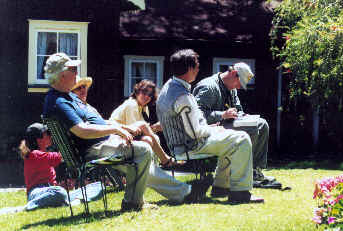
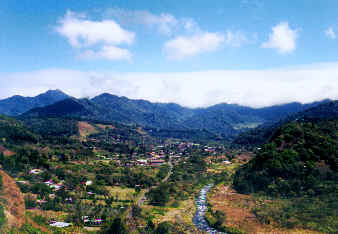
In the Chiriqui
Highlands, some of the FONT tour group looking at hummingbirds at a coffee finca
(left), and a view of the town of Boquete in a valley surrounded by
mountains.
(Photos by Marie Z. Gardner, during FONT tour. - © all rights reserved)
Later in the day, along a rushing stream, there were Sunbittern, Dipper, and Torrent Tyrannulets. The last of these we observed during the final moments of daylight as a pair tucked in to spend the night in a cluster of foliage hanging above the water.
As the tyrannulets' day ended, so did our series of fine encounters with birds of the Panamanian highlands. Or nearly so. A Tropical Screech-Owl called in a tree outside our windows after dark.
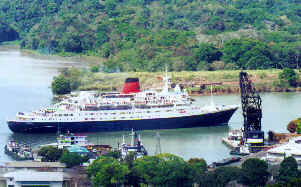
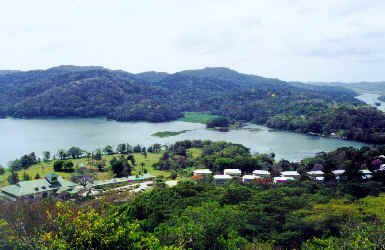
Views from the tower a
Gamboa. The Panama Canal (left) and the
Gamboa Lodge (right). (Photos by Marie Z. Gardner, during FONT tour - ©
all rights reserved)
Wonderful birding in Panama continued when we went to the lowlands in the basin of the Panama Canal.
We went to the Canopy Tower, from which we saw Blue Cotinga and Green Shrike-Vireo. Along the Pipeline Road, we met upon another Sunbittern. We had a Three-Motmot Morning and a number of looks at trogons and other birds of the tropical forest.
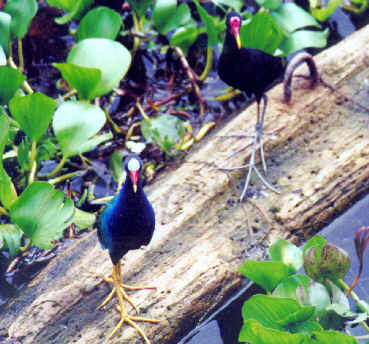
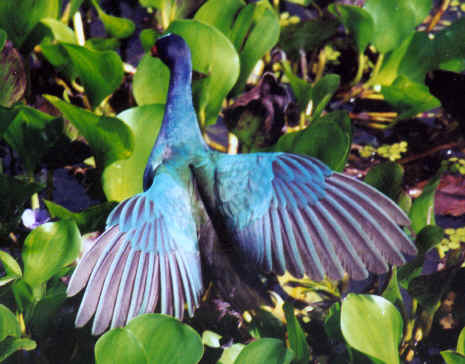
At Gamboa, as we lunched in an outside restaurant by the edge of a lake, there were both Green and Striated Herons, together with Purple Gallinules and Wattled Jacanas. Nearby, there was a conspicuous pair of Southern Lapwings and vocal White-throated Crakes. After dark, along the shoreline, there was the Gray (formerly called the Common) Potoo.
Not too far way, in an area of dry forest, we were with Lance-tailed Manakins and Rosy Thrush-Tanager. A Song Wren sang its beautiful long song. In the late-morning we came upon a Rufous Nightjar, that stayed, ever so still, on the ground, nearly at our feet.
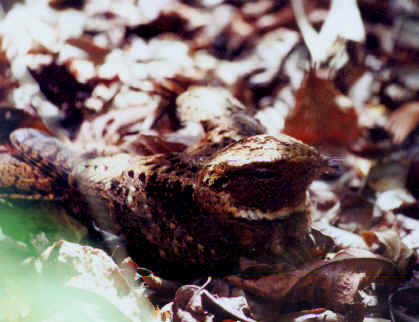
As good as it was to be eye-to-eye with birds in the canopy, such as the Green Shrike-Vireo, and Scarlet Tanagers and Philadelphia Vireos on their way north, it was on the ground where he had some of our best finds, particularly where there were ants - marching ants, on the soil, leaves, branches, vines, and twigs. These ants were accompanied by birds. As we stood still, we watched a number of Bicolored Antbirds, Spotted Antbird, Dusky Antbird, Ocellated Antbird, Gray-headed Tanagers (mostly yellow), Plain-brown Woodcreeper (yes, mostly brown), and even a Blue-crowned Motmot on the ground. As the ants stayed, so did the birds. A Black-faced Antthrush walked through the foray. Nearby, a Spectacled Antpitta was seen on the ground, and Pygmy Antwren and White-flanked Antwren were in the tangles.
With another ant swarm, at a place with dense brush, there were again a number of the antbirds, just-mentioned, but with them the seemingly "huge" and glossy iridescent-blue Greater Ani, also drawn to the ants, and making an assortment of strange sounds long hisses sounding like something electronic or, as it has been written, like a boiler.
So it was that during our week in Panama, we had some wonderfully good experiences with birds.
The "Top Birds" as voted by participants after the tour were:
1 - Resplendent Quetzal
2 - Three-wattled Bellbird
3 - Slaty-tailed Trogon
4 - Blue Cotinga
5 - Ocellated Antbird
6 - Keel-billed Toucan
7 - Lance-tailed Manakin
8 - Blue-hooded Euphonia
9 - Bay-headed Tanager
10 - Fasciated Antshrike
Additionally, 37 other species of birds
received votes.
Itineraries for upcoming Panama tours.
![]()
The following account written by Armas Hill, leader of
the tour.
The March 2002 Puerto Rico
Tour was the 24th FONT birding tour on that island.
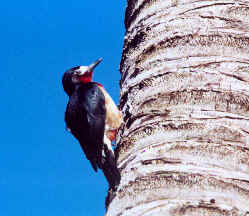
The Puerto Rican
Woodpecker,
one of the endemics during our March 2002 tour.
Photographed by tour participant, Peter Ferrera.
All of the avian endemics and specialites that we sought were seen well, with the exceptions of the very rare Puerto Rican Parrot, and the rare Puerto Rican Nightjar (which we heard well!).
Nearly a hundred species of birds were seen during the tour (including nearly all of 16 Puerto Rican endemics or near-endemics - as 1 or 2 of them also occur in the Virgin Islands).
If the Puerto Rican Screech-Owl is still in the Virgin Islands, it's very rare there, but we had some tremendous encounters with it in Puerto Rico. We saw 2, closely, sitting together on a branch, after dark, dueting with their loud cackling calls. One was light-colored with strong facial markings, the other quite reddish. During another night, we saw another owl, also closely, looking at us, raising it wing, and also making an assortment of noises. Its photograph is below.
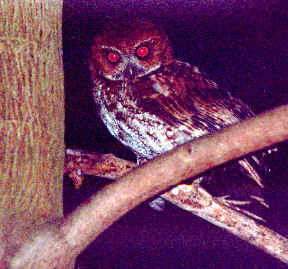
Puerto Rican
Screech-Owl
Photographed by tour participant, Peter Ferrera.
Changes in bird taxonomy have
changed what we say during our current Puerto Rican tours compared to
those in the past:
We now say "Puerto Rican Spindalis" instead of "Stripe-headed
Tanager". We say "Puerto Rican Pewee" rather than "Lesser
Antillean". We say "Greater Antillean" rather than Black-cowled
Oriole. And now we think of the Adelaide's Warbler as a Puerto
Rican endemic, since the split-off of the Barbuda and St. Lucia Warblers.
A photograph of the Puerto Rican Adelaide's Warbler is in our Caribbean bird
photo gallery.
West Indian Whistling-Ducks are very rare in Puerto Rico (we see them
more commonly to the west in Jamaica and the Cayman Islands). But we saw 3
during our March 2002 tour, in eastern Puerto Rico, as they flew into tall grass by a
pond. 4 Least Bitterns continued to be seen in the tall grass, and a
number of White-cheeked Pintails stayed in the open on the pond.
During our March 2002 tour, we
had wonderful looks at 2 Elfin Woods Warblers. Everyone in our group saw
them well, a feat, as the bird is notorious for giving fleeting glimpses as it
darts about in brushy undercover. Actually, the bird escaped detection by
ornithologists until just about 30 years ago.
We also enjoyed wonderful looks (in a comfortable setting: lawn and poolside) of
one of the rarest of birds, the Yellow-shouldered Blackbird.
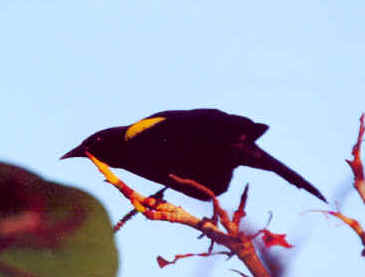
Yellow-shouldered
Blackbird
Photographed during March 2002 tour by Peter Ferrera.
Sometimes the Mangrove Cuckoo can be hard to see, in, for example, Florida. In Puerto Rico, the species occurs in habitats other than mangroves, notably in dry areas. We saw this species very well, more than once, also in some pleasant settings along the southern coast of the island.
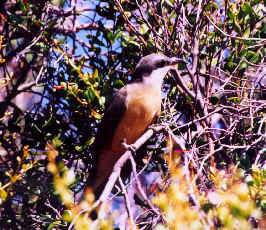
Mangrove
Cuckoo
Photographed during March 2002 Puerto Rico tour by Peter Ferrera
But, it was in northern Puerto Rico, in a beautiful forest in the Haystack
Hills, we had an encounter with another species of cuckoo, that was to be a
foremost sighting of the tour. We watched a Puerto Rican Lizard-Cuckoo
watch us, as it did a circle in the trees around us, calling as it went. It was
voted our "top bird".
Over the years, the Puerto
Rican Tody has received the "top bird honor" more than any other.
In 2002, the cuckoo notwithstanding, we still loved the tody.
The "Top
Birds" as voted by participants after the tour were:
1 - Puerto Rican
Lizard-Cuckoo
2 - Puerto Rican Tody
3 - Elfin Woods Warbler
4 - Puerto Rican Sreech-Owl
5 - Puerto Rican Woodpecker
6 - White-cheeked Pintail
7 - Puerto Rican Emerald
8 - Antillean Crested Hummingbird
(the male, a stunner!)
9 - Yellow-shouldered Blackbird
10 - "Puerto Rican Rooster" (they're
everywhere, seen & heard, yes heard!)
11 - Magnificent Frigatebird
12 - Mangrove Cuckoo
13 - Puerto Rican Spindalis
14 - Clapper Rail (watched
for a while)
15 - Adelaide's Warbler
16 - Venezuelan Troupial
The following letter was received by FONT after the
March 2002 Puerto Rico tour by participants, Bud and Edna Schaffler, of
Manahawkin, New Jersey, USA:
Dear Armas,
We want to express our appreciation to you for the wonderful
birding tour in Puerto Rico. You put together an excellent tour and did a great
job leading. It was a trip we shall always remember.
The birds were great as was the scenery and the food. We hope
that next year we'll be able to join you on another tour in another area.
As noted above, we did not see the very rare Puerto Rican Parrot in March 2002. The species, now
very rare in the wild (about 40 birds), nests during that month, with females on
eggs.
However, in July 2002, when seeing the bird should be easier, we'll be doing
another Puerto Rican birding tour. A superlative effort will be made to see the
parrot at that time!
Itineraries for upcoming Puerto Rico tours.
![]()
Lesser
Antilles Tour
(St. Lucia, St.
Vincent, Dominica)
March 2-10, 2002
with:
Caribbean Seabirds & Cetaceans, including Great Skua, Tropicbirds, and
Fraser's Dolphin
The following account written by Armas Hill, the leader
of the tour.
Off the coast of the West Indian island of Dominica (one of 3 islands visited
during our FONT Lesser
Antilles March 2002 birding tour), there was, once again, on
March 9, a pelagic trip,
where the water gets deep (over 1000 feet) very closely offshore.
Previously, during this pelagic
trip, we've seen very some interesting cetaceans, including Sperm and Dwarf
Sperm Whales, and Fraser's and Spotted Dolphins. This
time, we again saw Fraser's Dolphins (about 50 together) and Pantropical
Spotted Dolphins (about a hundred at once). Sperm Whales were in the
area, but we did not see them, or hear them (with the hydrophone).
But we did see a wonderful assortment of seabirds. During this trip
previously, also in March, we saw Pomarine Jaegers. This time we saw
about 25 Pomarines, as well as one Great Skua.
Various times at the surface of
the sea, there were schools of fish. They appeared to be small tuna. Jaegers
were feeding on them. Boobies were diving into the water. Frigatebirds
were overhead in a swarm. Some were coming to the water grabbing fish. Others
were harassing jaegers.
During the trip we saw groups of both Brown and Red-footed Boobies.
At another time, as we were cruising off the beautiful coastline, with the forested hills of Dominica as a backdrop with puffy clouds and rainbows, a White-tailed Tropicbird flew in above us, with its long tail against a blue sky.
A few days earlier, during the tour, when we were atop a high sea-cliff on the island of Saint Lucia, there were about 50 Red-billed Tropicbirds gracefully flying about, calling as they flew.
Our fine day at sea on March 9, 2002 ended with the sun setting over the Caribbean Sea, where we had seen the boobies, jaegers, skua, frigatebirds, tropicbirds, and 2 Lesser Black-backed Gulls (2 of only 4 gulls seen, the others Laughing). As the red solar ball dipped below the horizon, we could see the quick "green flash".
Seabirds were just part of our tour in the Lesser Antilles. There were also some wonderful landbirds, such as parrots (on St. Lucia, St. Vincent, and Dominica), colorful hummingbirds (including 2 caribs), and various endemics, rarities, and other specialties (among them: two tremblers, the White-breasted Thrasher, the Forest Thrush, flycatchers, and three indigenous warblers: Plumbeous, Whistling, and St. Lucia). Also on St. Lucia, an endemic oriole. Link to a complete list of the birds during FONT Lesser Antillean Tours.
The "Top Birds" as voted by participants after the March 2002 tour were:
1 - Red-footed Booby
2 - Purple-throated Carib
3 - Great Skua
4 - Brown Trembler
5 - Red-billed Tropicbird
6 - Imperial Parrot
7 - St. Vincent Parrot
8 - Rufous-throated Solitaire
9 - White-tailed Tropicbird
10 - Red-necked Parrot
11 - St. Lucia Parrot
12 - Green-throated Carib
13 - White-breasted Thrasher
Itinerary for the 2003 Lesser Antilles tour.
![]()
Japan
Winter Birding 2002
Tour JA-1: Hokkaido, Honshu, Kyushu: Jan 15-26
Tour JA-2: Amami, Okinawa: Jan 26-31
with:
Blakiston's Fish-Owl
cranes, eagles, and much more
Written by the leader, Armas Hill, following
the
16th FONT Japanese birding tour.
Bird highlights during the tours were many, ranging from 2 Blakiston's Fish-Owls, close at hand, to 5 rare Pryer's Woodpeckers. There were 7 of the world's 15 species of cranes. There were both of the Eagles of Hokkaido, the White-tailed and the Steller's. Baikal Teal was sought and found. The most Mandarin Ducks for us ever were seen. Whooper Swans were enjoyed, calling on water of a cold lake enshrouded in mist. Not just Blakiston's, but other owls provided experiences not to be forgotten. And yet another bird of the night provided quite a show, the rare Amami Woodcock.
As we birded the country of islands, from one end to the other, from cold Hokkaido to warmer Okinawa, each day, being different from the others, had highlights unto itself. Day by day, descriptions follow.
We began in Tokyo on January
15. In the "green island" of trees in the city, at the Meiji
Shrine, we saw our first Varied Tit, Japanese Bush-Warbler, Red-flanked
Bluetail, Dusky Thrush, Japanese Pygmy-Woodpecker, Hawfinch, and a
flock of about 50 Mandarin Ducks. A good way to start. A Sparrowhawk
flew quickly overhead. Large-billed Crows made their assortment of calls.
Earlier in the day, we saw our only Azure-winged Magpies of the tour. The
subway rides to and from the shrine were fun, and enjoyable to see at the shrine
was a wedding. Our first day in Japan was actually a national holiday
("Coming-of-Age Day"), and we saw a number of Japanese ladies in
attractive kimonos.
In the afternoon, at another Tokyo park, we saw our first Kamchatka Gull,
Smew, and numerous other ducks. At night, north of Tokyo, we
boarded a ferry headed for Hokkaido, on which we soundly slept.
During January 16 our pelagic day on the Pacific Ocean, off Honshu, nearly 40 Laysan Albatrosses were tallied. An immature Short-tailed Albatross was seen, but not by all. There were numerous Common and Thick-billed Murres. As the ferry plowed north, all of these murres (or guillemots as they are otherwise known), were apparently unable to fly, as they scurried away from us on the water. Other alcids included: Ancient Murrelet, Crested Auklet, and Tufted Puffin. Kittiwakes were plentiful. Northern Fur Seals were seen floating on the surface of the ocean.
Onshore this evening, nestled away in the woods of Hokkaido, we enjoyed our first, and one of our best, traditional Japanese dinners.
The morning of January 17 began with snow gently falling. Tree branches and the ground were covered with a few fresh inches making a beautiful sight and a nice backdrop for some birds that would be attractive anyway, Common Bullfinches with their subtle rosy-and-gray coloration. Five species of tits, a nuthatch, and a jay, were enjoying their breakfasts at bird feeders outside the windows of a room where we were enjoying ours. In nearby trees, there were White-backed and Grey-headed Woodpeckers. In the afternoon, we travelled east across Hokkaido. Animals along the way included Sika Deer, Red Fox, and Arctic Hare.
On January 18, we spent a good part of a very good day with as many as 180 Red-crowned, or Japanese, Cranes, as they were calling, leaping, and sometimes just standing gracefully on the snow. That afternoon, a man dispersed some small fish on that snow, and the cranes were joined by a number of White-tailed Eagles and Black-eared Kites. The raptors flew in close to us, as they lowered their talons to the ground grabbing the fish.
Our day ended with a close look at 2 huge Blakiston's Fish-Owls, shortly after sunset. They both perched in a bare tree not far from us. As a light shone on them, we saw them so very well. Happy we were, sleeping that night so very well.
On January 19, we saw as many as 120 Harlequin drakes and ducks along the shoreline of the Shiretoko Peninsula in eastern Hokkaido. Also that day, along that wintry coast, our tally of magnificent Steller's Sea-Eagles was 170, both immatures and adults. Birding doesn't get much better, anywhere, than it was for us this and the previous day.
The 19th of January began with
some flocks of Whooper Swans along the edge of a large lake. The large
white birds would be obvious enough, but they made their presence all the more
known with their loud calls.
Also white were the estimated 2,400 Glaucous Gulls we saw this day along
the seacoast. But that species was not the most numerous. We estimated about 9,000
Slaty-backed Gulls.
In the air, Rough-legged Hawks hovered. On the ocean and bays, there were
many ducks (Common Scoters were common), and other waterbirds
such as Pelagic Cormorant and Red-necked Grebe.
Small birds this day were few (that was fine with all the good big ones), but
notable were our first Brown Dippers, in frigid waters of streams. We
were to see these little dapper dippers on three islands during our stay in
Japan.
January 20 was a travel day - in a van, on a plane, in a bus, on the bullet-train, and then another van. We went from Hokkaido back to the main Japanese island of Honshu. We passed by many people this day as we traveled, but where we ended up was an uncrowded and quite beautiful place on the shore of the large Lake Biwa.
On January 21, we saw
over 200 Falcated Ducks among the many waterbirds (ducks,
grebes, cormorants, and gulls) at Lake Biwa. On a small
pond, nearby, we saw another species of duck that's "a must" during a
winter visit to Japan, the Baikal Teal. Formerly common, now overall the
bird is a rarity. The drake, boldly patterned, is a sight. Other waterfowl this
day included Bewick's Swans and Bean Geese.
Little villages by the lake, with narrow streets and characteristic
architecture, were "so very Japanese". Birds there included Japanese
Wagtail, Daurian Redstart, and on fancy roofs, Blue Rock Thrush.
Nearby, we saw Japanese Macaques, also known as "Snow
Monkeys". We actually saw them in times of drizzle and sunshine, but
when we went higher into the hills, they were amidst flurries of falling snow.
January 22 began with the red round ball of the Sun rising over the
opposite shoreline Lake Biwa. Japan is "the Land of the Rising Sun".
Later, high in a clear sky, a Hodgson's Hawk-Eagle was the first of two
"firsts for FONT tours". The other "new bird" for FONT
Japanese tours would be later in Kyushu.
Also in the area of Biwa-ko (as Lake Biwa would be in Japanese), there
were, on the ground, Grey-headed Lapwings and Long-billed Plovers.
Both Japanese Green Woodpecker and Japanese Green Pheasant were
seen, the latter a lone male in a field. It was the only "Kiji" during
the tour. This native pheasant is the national bird of Japan.
After over-nighting in Kyoto, we flew on January 23 to Kyushu, where we had our first taste of birding on that most-southerly of the main Japanese islands. Along a stream, there were a few Mandarins, a dipper, and a Crested Kingfisher. Then, there were CRANES - many of them!
On January 24,
participants on our tour saw 6 species of cranes wintering in the area of
Izumi, on Kyushu. There were about 5 thousand Hooded Cranes and over 2
thousand White-naped Cranes (the bulk of the world's population of these
2 species). With them were some Common, or Eurasian, Cranes (we
saw 2), Sandhill Crane (some of us saw 1), a lone Siberian
White Crane (which we saw well on the ground - once much a loner, by
itself - and heard it call in flight above us), and last, but certainly not
least, a pair of stately Demosielle Cranes sharing a field with some Hooded
and White-naped.
We experienced daybreak with the cranes. As the sun rose, the cranes
called. Flocks flew about.
Among other birds we saw this day were the rare Black-faced Spoonbill, a Ruff,
Daurian Jackdaw, and a flock of nearly 25 Chinese Penduline-Tits. The
last of these winter in Japan, coming from somewhere in China.
In the morning on January 25,
we saw the second of the two birds during the tour "new for FONT in
Japan". There were 2 Pallas', or Great Black-headed Gulls,
where we saw, also, 3 Saunder's Gulls. All of these came to winter along
the western Japan coast from mainland Asia.
Later in the day, in highlands, we saw Yellow-throated, and other Buntings,
Japanse Grosbeaks, and Bramblings.
Along a river in the hills, in eastern Kyushu, that afternoon we had a rough
count of 200 Mandarins. On the blue-green water, the colorful ducks were
absolutely beautiful. Had we been able to stop more often along the road in the
valley, we may well have seen even more of these fine birds. In that region, in
the prefecture of Miyazaki, during a mid-winter waterfowl count in 1995, a total
of 796 Mandarin Ducks were found. That winter, in all of Japan, 18,703 were
counted.
But the Mandarins were not all there was to see along that road in the river
valley. Late in the afternoon, there was a Ural Owl perched, roadside, on
a wire. After we turned around, we stopped and got out of our vehicles, and then
saw the dark owl in our scopes. Yes, it stayed - in fact, it was reluctant to
leave. When it flew it was just for a short distance to another place on the
wire. It was a great way to end our day, and our Kyushu birding.
On January 26, some of us said good-bye, and others continued south on the next tour segment to include Amami and Okinawa.
On January 27, on a beach
on the island of Amami, at one time in front of us, there were 7 species of
plovers. As the tide was coming in, the birds got closer and closer. There
were about 500 Kentish Plovers, and nearly 400 Mongolian, or Lesser
Sandplovers. With them was one Greater Sandplover. Thus there was a
fine comparison of the Greater and Lesser. Also in the mix along
that shore were 2 Long-billed Plovers (unusual that far south), a
number of Little Ringed Plovers, about 70 Pacific Golden Plovers,
and 25 or so Grey, or Black-bellied, Plovers.
Earlier in the day, elsewhere on Amami, we saw the colorful endemic Lidth's
Jay.
And later, on January 27, after darkness fell, we observed a Long-eared Owl
hunting along a dirt road in the forest. Animated it was, with its orange eyes
wide open. But it was using its ears more than it eyes as it tilted its head at
various angles. From our vehicle, we watched the owl, in front of us, hover over
the road across which mice ran.
A little later yet, that night, in front of us in our stopped vehicle, we
watched an endemic Amami Woodcock, standing on the road. It was in no
hurry to go. In fact, after wandering for a moment off the road, it came back,
giving us yet another tremendous look at a threatened species.
Early the next morning, on January 28th, along a dirt road in the forest, we had a look at the rarest of the Amami endemics, the Amami Thrush.
In the Okinawa forest, on
January 30, 5 Pryer's Woodpeckers were seen. It is said that over the
years the population of this species has ranged from 40 to 100 birds. Thus,
assuming the Ivory-billed Woodpecker to be extinct, this woodpecker endemic to
northern Okinawa could well be the rarest woodpecker in the world. It's quite a
bird, with its large, bright bill.
The Okinawa Rail eluded us this time. Sometimes we see it, usually we hear it,
but in January 2002 for us it was not to be. Incidentally, that forest rail
eluded science until 1981.
Among birds that we did see on Okinawa, however, were some good ones indeed. In
a paddy, both female and male Painted-Snipe were seen nicely. As with
phalaropes, female Painted-Snipes are the more colorful - very nice to see. Also
in areas of paddies, we enjoyed looks at the bright Cinnamon Bittern, Pacific
Golden-Plovers in various plumages, and among many Common, or Fantail,
Snipe, there were 1 or 2 Pintail Snipe. These were among about 25
species of shorebirds, or waders, we saw on Okinawa. Also notable
among them were both Eurasian and Far Eastern Curlews, Red-necked
and Long-toed Stints, and Grey-tailed Tattler. Again, as on
Kyushu, there were 3 Saunder's Gulls from China.
Also from China, or elsewhere in
Asia, some vagrant starlings were visiting Okinawa when we were. At one farm
pasture (and there aren't many in Okinawa), there were with some Grey
(or White-faced), a single White-shouldered (or Chinese),
and a few Common Starlings.
(The next day, there were also 3 Silky, or Red-billed,
Starlings). None of these routinely occur on Okinawa - in fact,
during our tours in the past, we've never seen a starling of any kind on the
island.
During our Okinawan nights and early mornings, as we were out and about, we had
good looks at what's now called the Japanese Scops-Owl (formerly
included in the Collared Scops-Owl).
As you've read, our January 2002 Japan Tour was a good one for owls - and many other birds as well!
The "Top Birds", as voted afterwards by the dozen or so tour participants, were:
# 1 - Blakiston's Fish-Owl
# 2 - Red-crowned (Japanese) Crane
# 3 - Steller' Sea-Eagle
# 4 - Amami Woodcock
# 5 - White-naped Crane
# 6 - Pryer's Woodpecker
# 7 - Ural Owl
# 8 - Long-billed Plover
# 9 - Siberian Crane
#10 - Mandarin Duck
#11 - Demosielle Crane
#12 - Greater Painted-Snipe
#13 - Whooper Swan
#14 - Baikal Teal
#15 - White-tailed Eagle
That's good birding!
The following comment came in a letter after the
tour by participant, Mr. Sandy Gordon, of Cardross, Scotland:
Dear Armas,
Having got back home from Japan, I would like to thank you for taking such good
care of us during the tour.
I took back with me a host of memories of the birds, of the landscape of the
country, and the companionship of my fellow birders. We certainly got good looks
at the target species and it is astonishing that while Japan does not have a
great quantity of birdlife, so much of what it has is so special!
Also participating on the tour
were Janos Olah, Jr. and Zoltan Ecsedi (excellent birders who lead birding tours
for FONT in Hungary).
We soon hope to have some fine photographs of birds
taken during the tour here in the FONT web-site.
Upcoming
Japan Tours.
To
Top of Page
![]()
Guatemala
Dec 26, 2001 - Jan 5, 2002
with:
Ornate Hawk-Eagle
a pair of Orange-breasted Falcons
Pheasant Cuckoo
Resplendent Quetzal
Hummingbirds
and a number of other "good birds"
The following account written by Armas Hill, the leader
of the tour.
We've just returned from our annual FONT Holiday Birding Tour. This year, in
Guatemala. During previous years, since 1990, our "holiday birding"
has been in Costa Rica (a few years), the Dominican Republic, southern Spain,
and Japan (to usher in the new millennium).
Now, some of the highlights (and there were some!) during the just-completed Holiday Tour 2001/02 in Guatemala:
We were at Tikal, in the Peten
region of Guatemala, on January 4, 2002. Early that morning, we were walking
around the edge of a small pond looking for a Bare-throated Tiger-Heron, when to
our surprise, there was an adult Ornate Hawk-Eagle perched in a small
tree, no higher than 15 feet from the ground, and no more than 25 feet from us!
It stayed there as we watched
it, for over a moment, before flying into the higher canopy in the nearby
forest, where it caused a loud raucous by Brown Jays.
But that was not to be our only spectacular raptor sighting that day:
On an upper ledge of Temple 4,
the highest of the Mayan temples at Tikal, an Orange-breasted Falcon was
perched. The bird's nearly the size of a Peregrine. The species is quite a
rarity, occurring spottily in parts of Central and South America. It's a bird
rarely encountered. But we were fortunate to see not only one, but two of them,
a pair, on the temple, and in flight. We also listened to them calling to each
other.
When we climbed the high temple,
one of the two Orange-breasted Falcons 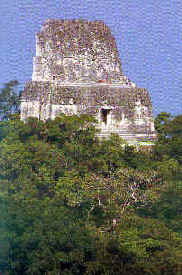 was sitting on a branch in a tall tree by
the temple. We saw it at eye-level, as the other bird was above us on a ledge.
The eye-level bird in the tree was close, about 40 feet away, with sunlight
shining on its bright orange breast.
was sitting on a branch in a tall tree by
the temple. We saw it at eye-level, as the other bird was above us on a ledge.
The eye-level bird in the tree was close, about 40 feet away, with sunlight
shining on its bright orange breast.
Years ago, the rare
Orange-breasted Falcon and the common Bat Falcon both occurred on the tall
temples at Tikal, above the surrounding jungle. But in recent years, the
Orange-breasted Falcon has not been there. It was such a treat that 2
Orange-breasted Falcons were there for us in January 2002.
Temple 4
Another treat we experienced at Tikal, the previous day, was an observation rarely had of a Pheasant Cuckoo. As we were walking along what was the old airfield, we heard, low to ground, in the dense brush, an odd sound. It was a bit like an electric motor. When we peered into the understory, we saw, very near to us on the leaf-covered ground, a brown-and-white jay-sized bird, walking about. It had a long and fanned-out tail. Its wings, lowered to the ground, were vibrating. We stood very still. The bird stayed. We watched it move about, slowly but erratically, with the continuous buzzing sound. Then, the Pheasant Cuckoo drifted away into the underbrush, and we left, wondering how many people have ever witnessed what we had just seen.
There was more, during our tour partly in 2001, and then into the new year:
We can truly say that the Year 2002 began for us, resplendently. Early in the morning, on January 1st, we were looking at 3 Resplendent Quetzals. We saw them both perched in trees and flying about, with their "long tails" dangling behind them. More than once, the 3 males flew from tree to tree, one after the other. When they were perched, we had wonderful looks at them in a telescope. As they were not far away, they were "full-frame" in the scope.
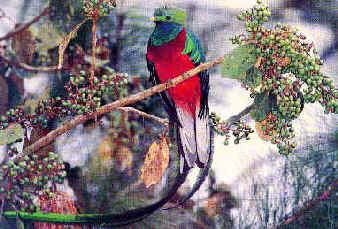
We were in the cloud forest, but
the sun was shining, that first morning of the year. The Resplendent Quetzal is
considered among the most spectacular of the world's birds. The male appears to
have a very long tail (actually it has 4 upper tail-coverts elongated into
slender streamers). In the sunlight, we saw the brilliant iridescent colors and
hues of green, red, gold, and blue.
The Resplendent Quetzal is the
national emblem of Guatemala. It's the national bird, and the name of the
currency. As we traveled about, we also saw it as names of a bank and a chain of
nationwide gas stations.
During that January 1st morning, in the trees around the quetzals, there were other fruit-eating birds, including the Highland Guan, Emerald Toucanet, and Azure-hooded Jay.
Singing in the background, was the Slate-colored Solitaire. As we were watching one of the world's most beautiful birds, the Quetzal, we were hearing one of the world's most beautiful songs, of the solitaire.
Other birds during the tour ranged from as large as pelicans and turkeys, to as small as hummingbirds:
When we were watching the
Orange-breasted Falcon atop a Tikal temple, a line of about a dozen Brown
Pelicans flew overhead. Brown Pelicans are not to be expected in the sky
there above the Peten jungle. The seacoast is far away. But some pelicans can
occur rarely at the large lake, Lago Peten Itza, about 60 kilometers west of
Tikal.
During a previous FONT tour, in
the Peten, the other American pelican, also a rarity in the region, was seen. A
single White Pelican was on a sandbar in a river, the Rio de la Pasion.
On the ground at Tikal, during our just-completed tour, one afternoon, 10 Great Curassows were seen, both black males and brown females. But probably that afternoon also, 10 times that many Ocellated Turkeys were seen, doing the same, walking on the ground, and then going into trees at the day's end to roost. The turkeys, with quite an array of colors in their plumage.
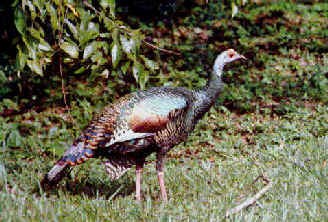
All hummingbirds are
small, some smaller than others. We observed a small one, the Little Hermit, in
the Tikal jungle, coming to a puddle to bathe. That species was one of 20 seen during the tour.
The smallest was the minute Emerald-chinned Hummingbird, just over 2.5 inches.
The largest was the Magnificent Hummingbird.
Particularly enjoyable to watch were the male and female Sparkling-tailed
Hummingbirds at a wonderful flower garden by Lake Atitlan - a beautiful bird at
a beautiful place.
But there were other gems too
including the Garnet-throated and Amethyst-throated Hummingbirds, the
Azure-crowned and Wine-throated Hummingbirds, and the Slender
Sheartail, just to
name a few.
We visited a butterfly garden,
also by Lake Atitlan. On the way in, we had a fine encounter with another hummingbird, the
Rufous Sabrewing.
Wedge-tailed Sabrewing,
Purple-crowned Fairy, and Buff-bellied and Rufous-tailed Hummingbirds
were among
the hummers we saw at Tikal.
In the highlands, one of the
most conspicuous hummingbirds was the White-eared. But also there were Ruby-throated, having journeyed, as we did, from North America.
A few more of our encounters with birds in Guatemala are worth mentioning:
In the forest at Tikal, our
paths crossed a few times with those of ants. And, at times, those ants had nice
accompaniments of birds.
At one such swarm, there were
about 25 woodcreepers, Tawny-winged and Ruddy, on or near the ground. They
stayed, with their feast, as we stayed, watching them along with Gray-headed
Tanagers (that name doesn't say it all - gray heads, yellow bodies).
At another swarm of ants, there
was another mass of birds. Among them Scaly-throated Leaftossers (3 seen on one
stem at once), foliage-gleaners, ant-tanagers, and warblers Golden-crowned
and
Kentucky (yes, Kentucky Warblers at an ant swarm).
Another interesting observation
we had at Tikal, one afternoon, was of 2 Gray-necked Wood-Rails preening
each other - delicately.
By the same pond, earlier that morning, we saw a Ruddy Crake quickly
emerge from the reeds and then disappear back into them.
Before concluding, mention has
to be made of warblers during the tour. There were many. And what
splashes of color!
In the highland forests of pines
and oaks, we saw all four of these species rather similar Black-throated Green,
Townsend's, Hermit, and Golden-cheeked.
We also saw Olive and Crescent-chested
Warblers, Slate-throated and Painted Redstarts, and a real splash, the
Red-faced Warbler.
But special in that forest was the exquisite Pink-headed Warbler, indigenous to
that region.
At Tikal, there were other
warblers - many of which migrated from eastern North America, from Blue-winged
and Worm-eating to Yellow-breasted Chat.
Mention has already been made of
the Kentucky, but the Hooded must also be noted. How dapper these colorful
yellow-and-black birds are in the forest! On a small slope, we watched 3 males
continuously chase each other, up and down the slope.
Another time, as a couple of us
sat for a rest on a log, 2 male Hooded Warblers lit next to us, just feet away,
before circling around us. Birds that we "go to see" in North America,
coming to see us!
THE "TOP BIRDS" OF THE DEC 01/JAN 02
GUATEMALA TOUR
as voted by participants at the tour's end:
Each participant voted for 7 birds.
Each bird 1 to 7 worth two points less, thus 14 to 2 points.
Tied birds in taxonomic order.
A 3-way tie for First Place:
1 - Orange-breasted
Falcon 36
1 - Pheasant Cuckoo 36
1 - Resplendent Quetzal 36
Not far behind:
2 - Ornate
Hawk-Eagle 30
The rest:
3 - Sparkling-tailed
Hummingbird 18
4 - Blue-crowned Motmot 12
5 - Ocellated Turkey 10
6 - Tody Motmot 8
7 - Red-capped Manakin 8
8 - Keel-billed Toucan 6
9 - Pink-headed Warbler 6
10 - Gray-necked Wood-Rail 4
11 - Collared Aracari 4
12 - Bare-throated Tiger-Heron 2
13 - Rufous-tailed Jacamar 2
14 - Hooded Warbler 2
17 species received votes. Only one species received votes by everyone; that was
number #2 bird, the Ornate Hawk-Eagle.
Cumulative List of Birds during FONT Guatemala Tours.
Upcoming Central America birding tours.
The following came by letter to FONT from Dec/Jan 01/02 Guatemala tour
participants after the tour:
From Elaine & Patrick Nye, of Guilford, Connecticut, USA:
Dear Armas,
It was, indeed, a great tour, Tikal being
the highlight. Just seeing that Pheasant Cuckoo would have made the trip
worthwhile - but there was so much more.
I'm sure we'll be traveling with you again.
![]()